11 Best Databox Alternatives in 2025: Reviews & Pricing
Databox is a great data analytics tool, but users say the platform can be clunky and unreliable, with poor customer support that takes weeks to reply to emails.
To help you find the best Databox alternative, we did three things:
- Spoke with our customers who previously used Databox.
- Scoured online reviews and community forums for the best alternatives.
- Consulted our data engineers for technical details of each alternative.
Full disclosure—one of these tools is ours. But that’s because we genuinely believe Whatagraph can ease the pains you're facing with Databox.
But we’re also not here to bash our competitors. We researched them thoroughly (and even tried them out) so you can really understand what they’re great at and if they’re best for you.
By the end of the article, we hope you’ll find a Databox alternative that fits your needs—whether it’s us or not.

Sep 24 2025●10 min read
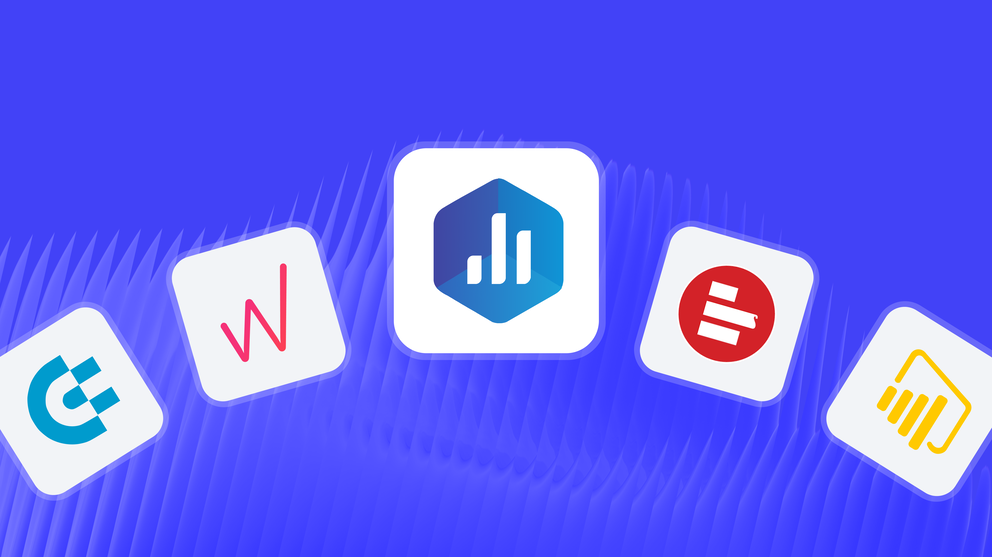
Based on ex-Databox users and reviews online, here are the biggest issues with Databox:
❌ Difficult to use: Databox’s interface can be a pain to navigate, especially for first-time users. You need to build dashboards and reports in two different environments, meaning you have to learn each one from scratch. Ex-Databox users we’ve talked to said they had to spend 2-4 hours on creating just one report.
❌ Unappealing UX/UI: Databox visualizes metrics in a “box” format, which is more suitable for internal use, rather than for external reporting. Metrics look squished and hard to read, which can overwhelm clients or the C-Suite.
❌ System outages: Databox users suffer from prolonged and frequent platform outages, some lasting up to 3 weeks. Even when the platform works, client-facing reports and metrics break very often, causing frustration.
❌ Inaccurate data: Due to these system outages and unstable integrations, users say their reports often show incorrect data (if they show data at all). Others say simple calculations were “wrong too often” and that they had to manually calculate metrics. This is dangerous if you're an agency as inaccurate data can cost you your client’s trust (and their business).
❌ Poor customer support: All these issues could be resolved with responsive support, but 90% of Capterra and G2 reviews complain about Databox's “terrible support and customer service”. Emails are ignored and critical issues take months to fix.
---
Sounds like a lot? That’s what we’re here for.
In this article, we’ll take you through 11 best Databox alternatives that are easier to use, more stable, and come with great customer support.
11 Best Databox Alternatives and Competitors in 2025
In a nutshell, here are the 11 best Databox alternatives we’ll review in this article:
- Whatagraph
- Klipfolio
- Tableau
- Looker Studio
- Geckoboard
- DashThis
- Grow
- NinjaCat
- Cyfe
- Improvado
- Tapclicks
Have a set of features you're looking for in an alternative? Compare them in this table:
| Features |
|

|

|

|

|

|

|

|

|

|

|
|---|---|---|---|---|---|---|---|---|---|---|---|
| Ease of use | Easy | Hard | Medium | Hard | Easy | Easy | Medium | Medium | Easy | Easy | Easy |
| No. of Out-of-the-Box Data Connectors | 55+ | 130+ | 100+ | 21 | 90+ | 34+ | 75+ | 150+ | 25 | 32 | 200+ |
| Custom API Access |
|
|
|
|
|
|
|
|
|
|
|
| Data Blending |
|
|
|
|
|
|
|
|
|
|
|
| Custom Metrics and Dimensions |
|
|
|
|
|
|
|
|
|
|
|
| Custom Reports and Dashboards |
|
|
|
|
|
|
|
|
|
|
|
| Campaign Overview and Monitoring |
|
|
|
|
|
|
|
|
|
|
|
| White-labeling |
|
|
|
|
|
|
|
|
|
|
|
| Data Update Frequency | Every 30 mins across all integrations and pricing plans | Depends on your pricing plan, from 4 hours to 30 minutes | Default is every 12 hours but you can set custom frequencies | Depends on APIs, from 15 mins to 4 hours | Depends on data source, from 1 to 60 minutes | Once a day or on-demand update | Custom frequency - from 15 mins to 1 hour | Every day or manual data refresh | Depends on the data source | ? | Automatically everyday or manual refresh |
| Data Segmentation and Filtering |
|
|
|
|
|
|
|
|
|
|
|
|
Alerts and Notifications
(out of 5.0)
|
|
|
|
|
|
|
|
|
|
|
|
|
Multi-Client Management
(with $$$ being the highest)
|
|
|
? |
|
|
|
|
|
|
|
|
| User Management | Admin, Manager, or Editor | Account Administrator, Klip Viewer, Klip Editor | Creator, Explorer, or Viewer | Viewer, Editor, or Owner | Admin and View Only | Users of the same account are considered "Admins" | Admin, Architect, Analyst, Visualizer, Consumer, or View Only | System Admin, Standard User, Restricted Partner, Dashboard User, Account Executive, and more | Account owner, Admin, Read only | Admin, Editor, or Contributor | Super admin, Business unit admin, Agent, Client |
| Automated Report Sharing |
|
|
|
|
|
|
|
|
|
|
|
| Data Export | PDF, XLS, CSV | Export dashboards as PDF or image files. Export only individual Klips as CSV | PNG, PDF, CSV | Google Sheets, CSV, Excel (only chart level) |
|
PDF only | CSV | Email, PDF | PNG, JPEG, PDF, CSV | PDF (only for reports) | Excel, Google Sheets, CSV |
| AI Insights |
|
|
|
|
|
|
|
|
|
|
|
| Customer Support | Live chat, email, Help Center for all pricing plans | Email, Help Center | Tableau community forum, Help Center, Email, Consulting services (for a fee) | Help center, community forums | Live chat, Email, Help Center | Email, Help Center for all pricing plans | Live chat, Phone, Email, Help Center | Live chat, Email, Help center, Academy | Email, Help center | Live chat, Email, Help center | Email, Help center |
| Dedicated Customer Success Manager |
|
|
? |
|
|
|
|
|
? | ? |
|
| Data Security and Compliance | ISO 27001, Enterprise SSO, GDPR compliant, AES-256 encryption, Two-factor authentication, AWS hosted servers | AWS hosted servers, 2048-bit RSA key access for servers, no passwords, SSL, RBAC | MFA, SSL/TLS encryption, ISO 27001, ISO 27012, ISO 27018, GDPR and CCPA compliant | ? | AWS hosted servers, HTTPS (128-bit TLS), RBAC, PCI DSS compliant | Encrypted URLs, Password protection, Restrict IP addresses, GDPR compliant | SSL encryption, SHA-encrypted passwords, Two-factor authentication, SOC 2 certified, GDPR compliant, DigiCert SSL, OAuth connections | GDPR complaint, DDOS protection, data encryption, MFA, RBAC | AWS hosted servers, OAUTH protocols | ? | HIPAA, SOC 2 Type II and SOC 3, HTTPS/TLS 1.2+, MFA, SSO |
|
Pricing
(with $$$ being the highest)
|
$ | $$ | $$$ | Free for native connectors | $ | $ | $$ | $$ | $ | $ | $$ |
Let’s dive into each of these tools.
1. Whatagraph
Most suitable for: Marketing agencies and in-house teams that need fast, accurate, and stunning reports without technical expertise
If you’re looking for an easier and more stable Databox alternative with excellent customer support, Whatagraph is the best choice.
Whatagraph is an easy AI-powered marketing intelligence platform that turns complex marketing data into clear insights, instantly.
Marketers use Whatagraph to connect all their channels, centralize reporting, and share impactful results, without needing technical expertise.
In a nutshell, here’s how Whatagraph works:
- Connect to 55+ marketing platforms automatically via native, stable connectors that don’t break.
- Easily organize your data—create custom blends, metrics, and dimensions using no-code workflows or AI.
- Ask AI to create reports by just telling it what you want it to build. Or use drag-and-drop widgets or ready-made templates to build one from scratch.
- Customize reports by just uploading a screenshot of your (or your client’s) brandbook or putting in a prompt. Host and share reports on your own domain.
- Get actionable insights instantly by just asking AI any questions about your connected data. Get it to write performance summaries directly in your reports in four different formats and 18 languages.
- Share reports as live links, PDFs, Excel spreadsheets, or automated emails. Transfer your data to BigQuery data warehouse or Looker Studio.
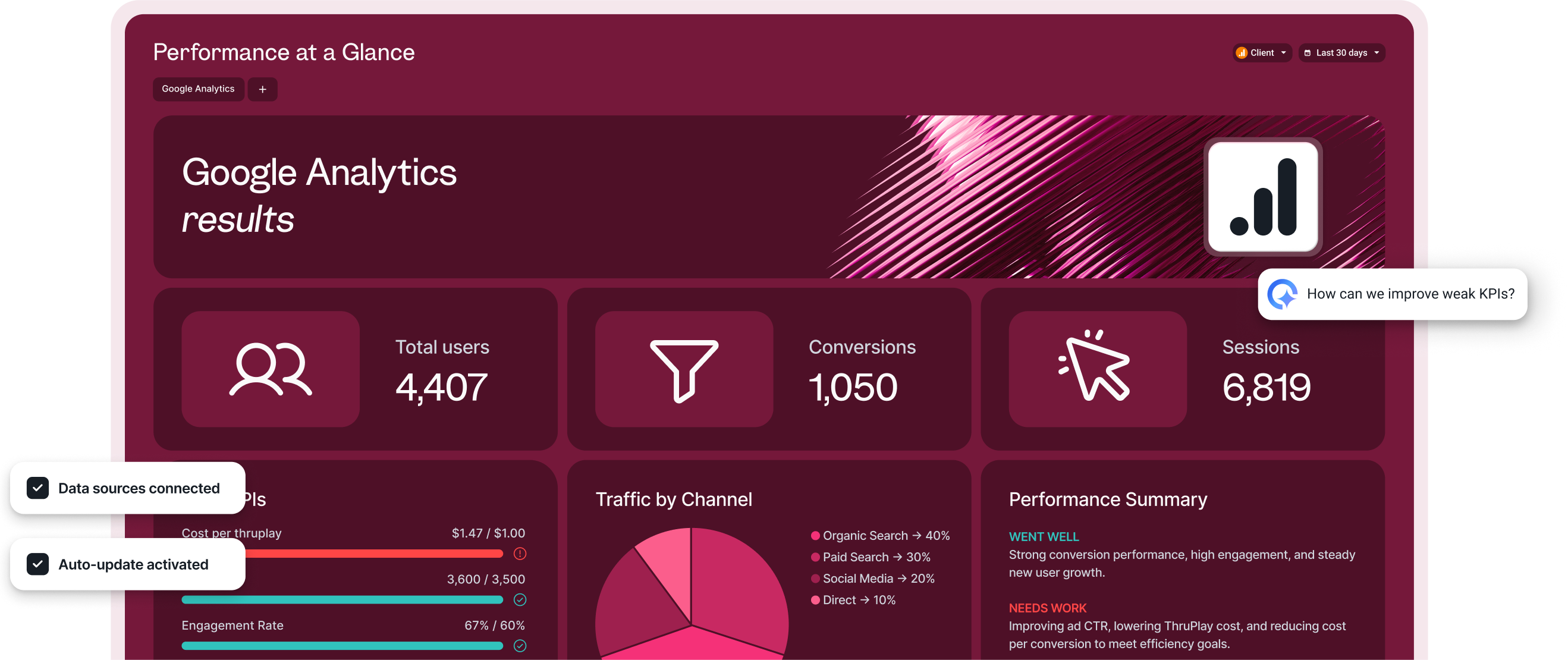
All this on one marketing intelligence platform means:
✅ You don’t need to spend hours wrangling with connectors and building dashboards from scratch.
✅ You don’t need to learn or pay for disparate tools.
✅ You get clean, organized, and white-labeled reports in minutes and share them instantly with teams or clients. No need to hire a data scientist to maintain them either.
✅ You get actionable, accurate insights instantly, and make decisions fast.
✅ There are less chances of data inconsistencies and breakages.
As Kim Strickland, Digital Marketing Specialist at Peak Seven and one of our power users, puts it:
Whatagraph has helped everyone on our team get on the same page about clients, what’s important, and how to talk to them. Our relationships with clients have been amazing, and we’ve even been able to retain them longer.
But how does Whatagraph compare against Databox exactly? Let’s take a look:
Databox vs. Whatagraph: Head-to-Head Comparison
Our Product team did extensive research on how Whatagraph compares against Databox and you can find the full breakdown here.
In a nutshell, here are six key ways Whatagraph outperforms Databox:
1. Stable, reliable platform with accurate data and metrics
The three biggest complaints we hear the most about Databox are:
❌ Unreliable: Databox has frequent, long-lasting outages, according to reviews like this one:
 ❌ Unstable: Templates, widgets, charts, and graphs on Databox often breaks. Hear from this one particularly frustrated user who wasn’t able to fully “launch” Databox:
❌ Unstable: Templates, widgets, charts, and graphs on Databox often breaks. Hear from this one particularly frustrated user who wasn’t able to fully “launch” Databox:
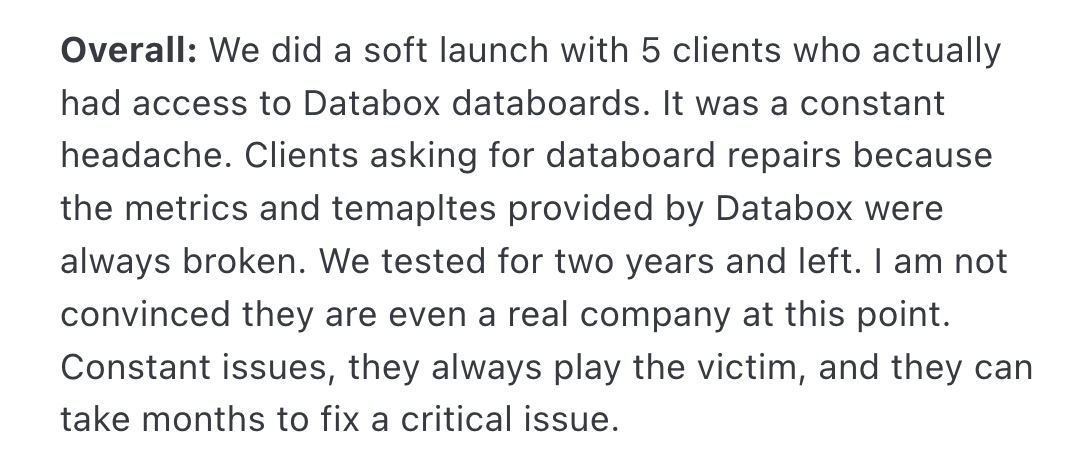 ❌ Inaccurate: Databox frequently shows wrong metrics and calculations on reports, requiring manual intervention. Take a look at this review:
❌ Inaccurate: Databox frequently shows wrong metrics and calculations on reports, requiring manual intervention. Take a look at this review:
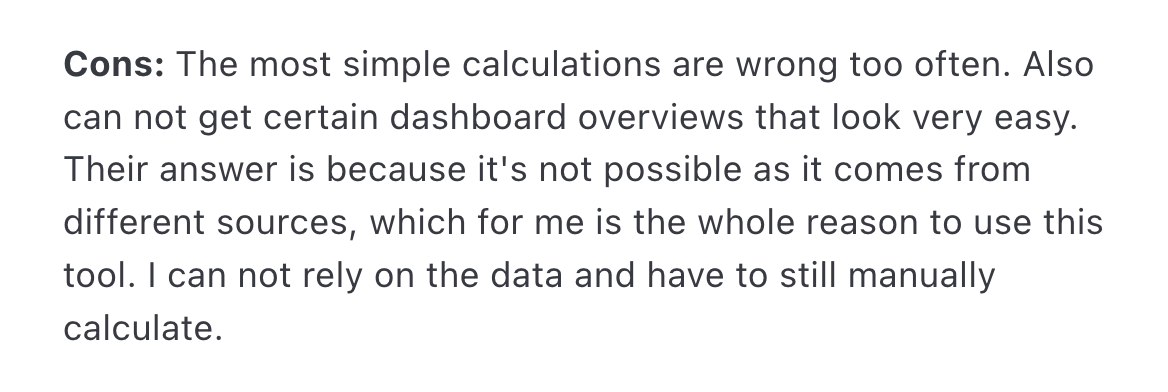 Whatagraph eliminates these pain points.
Whatagraph eliminates these pain points.
Our data integrations are fully-managed, which means they’re more seamless, stable, and reliable.
Our Product engineers regularly maintain these integrations so there would be less breakages and outages. We also have an emergency alert that will wake up our engineers (even if it’s 3 am where they are) to quickly fix system outages, if there are any.
Fully-managed integrations also mean bugs get resolved faster without needing to get a third-party company involved.
In terms of speed, you can work with 10 sources and 100 widgets at the same time on Whatagraph without slowing down the platform.
And thanks to a recent update to Google Kubernetes Engine, even reports with heavy widgets, tabs, and charts take less than 10 seconds to load on Whatagraph.
Plus, our dashboards have a consistent refresh rate of 30 minutes in all plans across all your reports, blends, and integrations. In comparison, Databox’s data refresh rate can range from 1 to 24 hours.
All of this means:
✅ There are no inconsistencies or “lateness” in the data on Whatagraph. It’s up to date every 30 minutes.
✅ Your reports load instantly and shows the right metrics. No surprises right before a meeting with your client!
✅ System outages (if any) are quickly resolved by our Product engineers who are on-call 24/7.
Our users love how seamless and stable connections are on Whatagraph. Here’s what Tanja Keglić, Performance Marketing Manager at Achtzehn Grad, says:
We don’t have any connection issues on Whatagraph at all. We just connected the platforms once, and that was it. Whatagraph is also very quick when loading the data.
2. Easier and faster to build visualizations
To create visualizations on Databox, you'll need to work with two environments: dashboards and reports. This means you need to create TWO different pages for one report, costing more time and effort.
In fact, ex-Databox users said they were spending 3-4 hours per report. Multiply that by 50 reports per month, and you’re spending 200 hours just on reports.
(Side note: There is an option to add a “dashboard” into a “report”, but this makes reports too overwhelming and hard to read.)
In contrast, on Whatagraph, you build one dashboard, and that doubles down as a report. You can white label this report easily, and download it as PDFs, share live links, or send automated emails to clients.
And with Whatagraph IQ, you can create, style and share dashboards in minutes, not hours. Here’s how:
- IQ Report Creation: Type what you need (“GA4 performance for September with YoY comparison”) and IQ builds the full report. No fiddling with widgets or layouts.
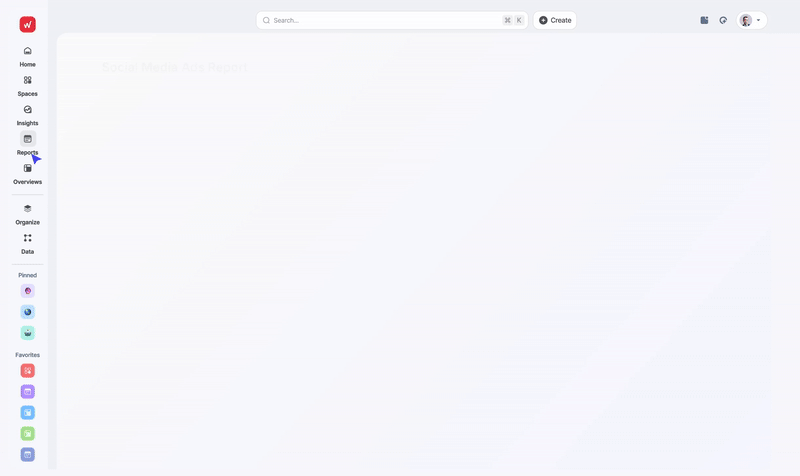
- IQ Widget Creation: On Databox, for each metric you want to visualize, you’ll need to spend time picking and choosing a widget type that would work best. For instance, you’ll need to choose from either a single widget vs. pie chart vs. table for a specific metric.
But with Whatagraph IQ, you can just ask AI to create a particular widget (e.g. bar graph, a pivot table, or a donut chart) and we’ll create it for you—complete with the metrics, dimensions, and filters you need.
- IQ Themes: Upload a logo or screenshot your client’s website, and IQ generates an on-brand theme in seconds. Fonts, HEX codes, icons—all styled automatically.
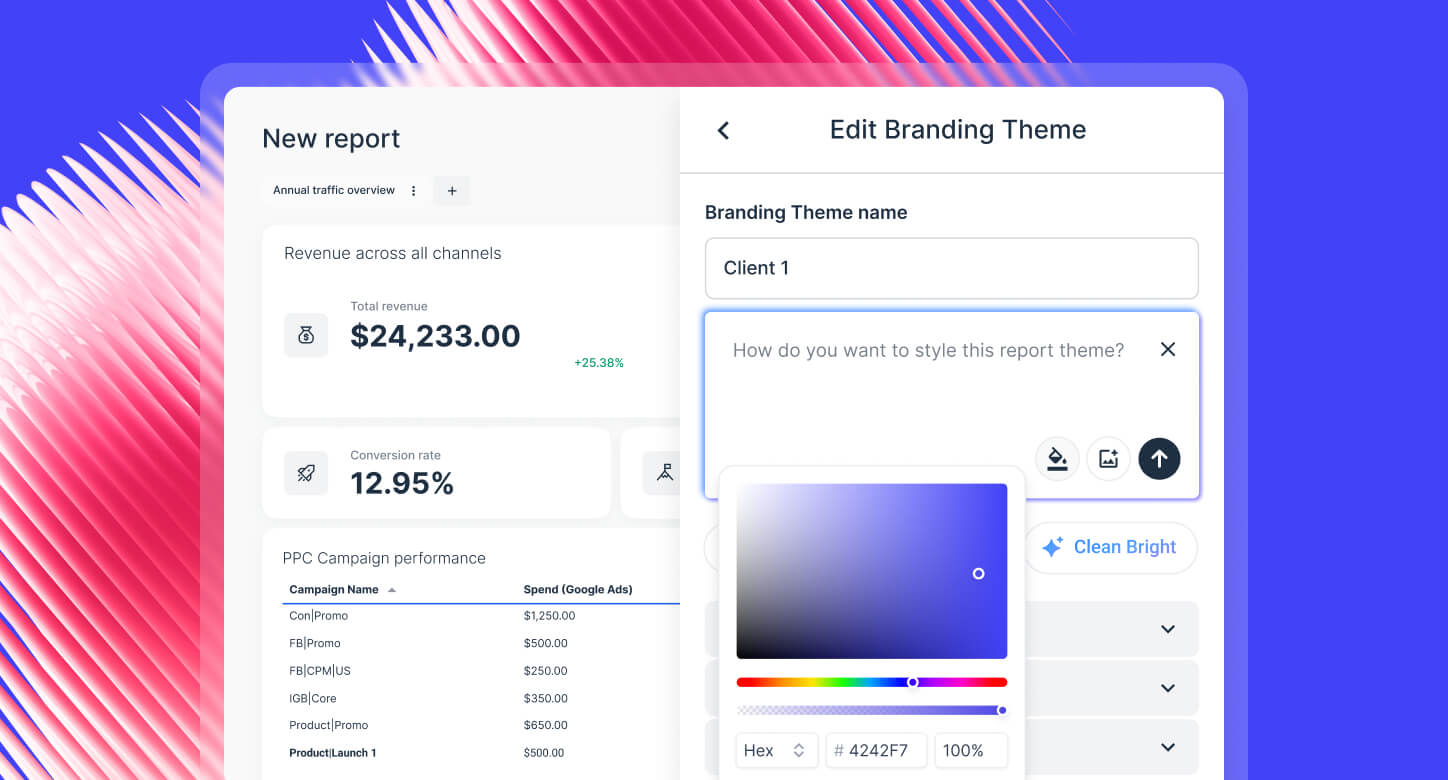
- IQ Chat: Ask questions in plain English: “Which campaign drove the most conversions this week?” Whatagraph gives instant answers with charts or numbers.
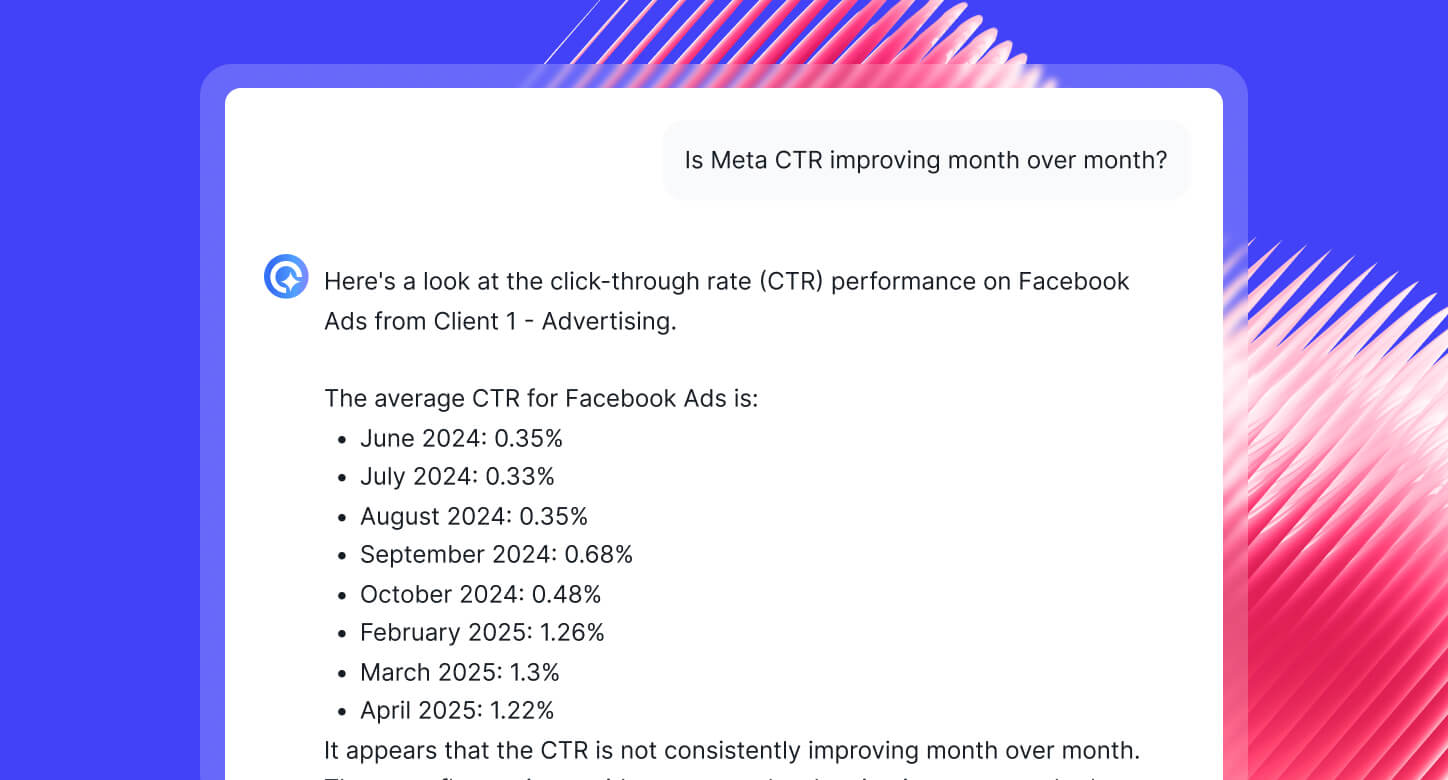
- IQ Summary: No more writing lengthy commentary for clients manually. IQ generates clear, accurate performance summaries based on the data on your report.
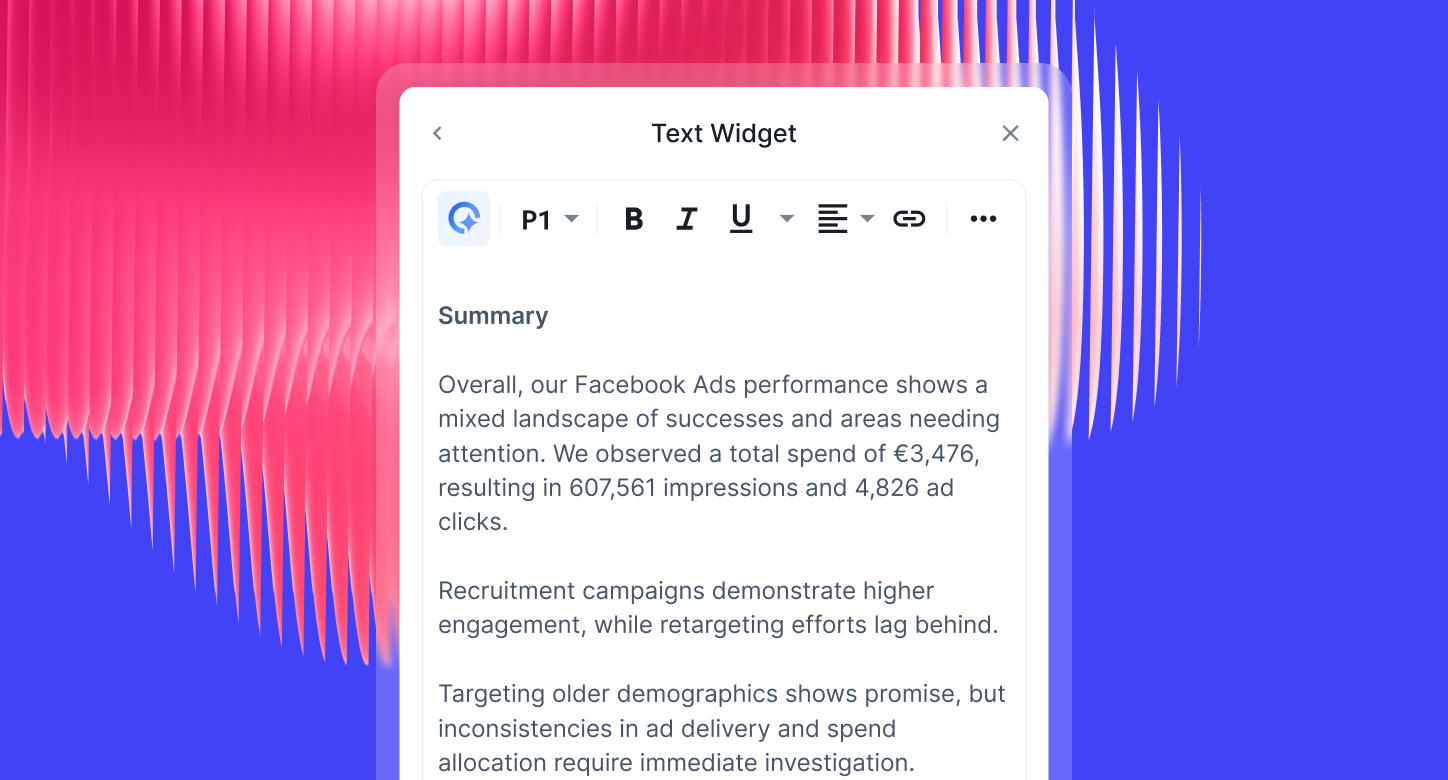
Start free with Whatagraph today.
Reports that would take hours in Databox are ready in minutes with Whatagraph.
And this is why agencies like Maatwerk Online are saving 100 hours a month on reporting, while Ampilio cut report creation time to just one hour per client.
Lars Maat, Co-Founder of Maatwerk Online says:
Whatagraph’s AI saves time and energy for our marketing specialists. And the hours we’re saving is just pure profit. We now have the time to focus on more strategic things that help both our agency and our clients grow.
Another feature that users love about Whatagraph is our folder management. You can create folders for each client, Account Manager, or campaign, and organize all the relevant reports underneath each.
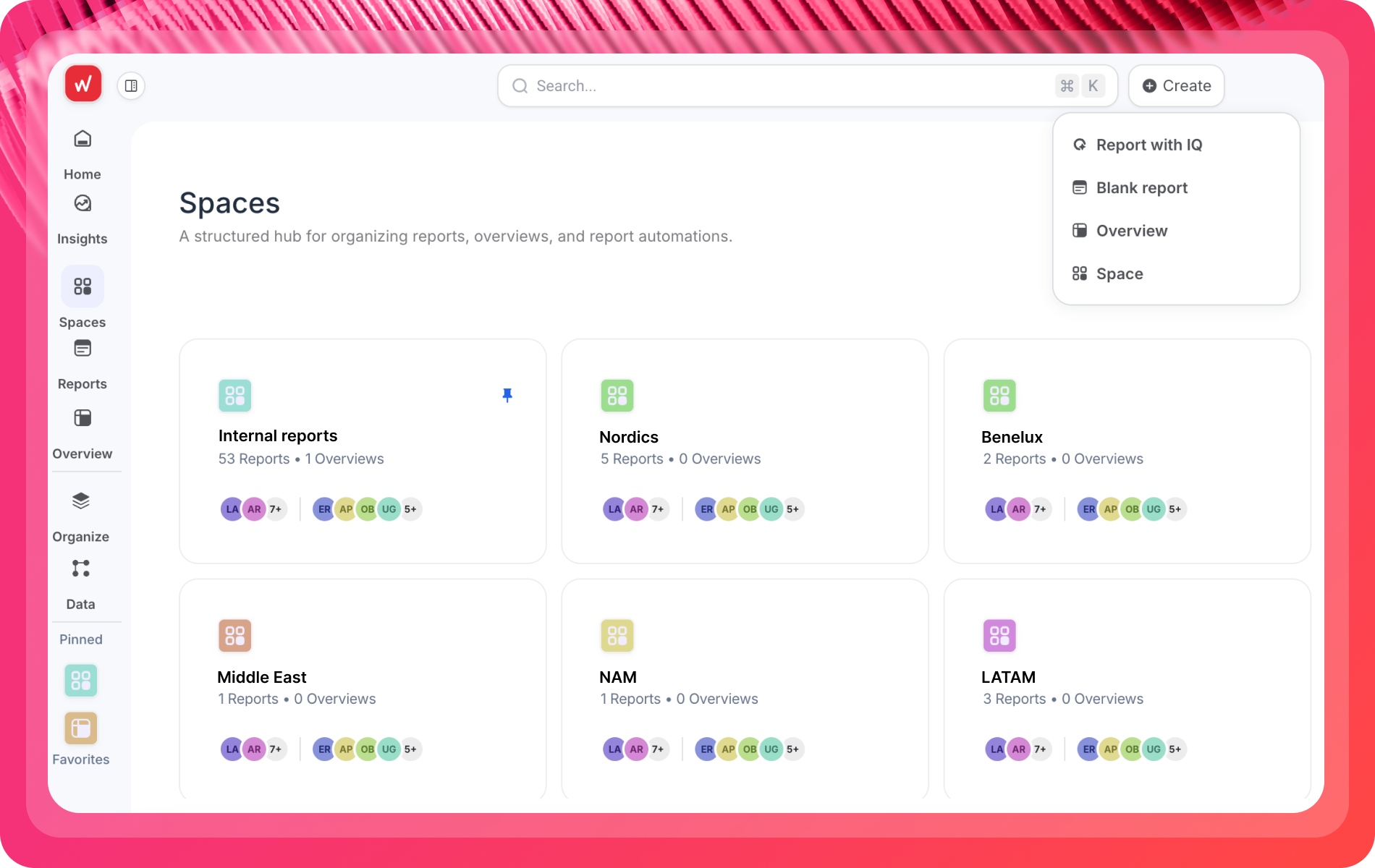
Whatagraph also comes with thoughtful design features that make your user experience smooth as butter. You can:
✅ Change the orientation of your reports as Landscape or Portrait
✅ Adjust the width and height of your charts and graphs right on the dashboard
✅ Save reports as “templates” and re-use them the next time
✅ Edit linked reports in one go, rather than one by one
✅ Add multiple “Tabs” within a single report to visualize performance from different channels or campaigns. This prevents lengthy reports that take ages to load.
3. Powerful (but easy) data organization features
If your data lives across dozens of sources, campaigns, and accounts, the hardest part isn’t pulling it in—it’s organizing it. Without that, reports get cluttered and it’s impossible to see the bigger picture.
On Databox, the only thing you can do is create custom metrics through a “Metric Builder” and “Calculated Metrics” which are both difficult to use, requiring complex workflows and SQL coding skills in some cases.
What's more, every time you want to create a metric, you'll need to leave your dashboard, create the metric in another tab, then go back to your dashboard. This wastes time and creates a lot of unnecessary hassles.
In comparison, Whatagraph makes it easy to group, organize, and monitor your scattered data and get actionable insights from it.
You can create data blends, custom metrics, and custom dimensions all through simple workflows that only take seconds to set up—natively from your report.
For instance, say you want to report on the total number of “Add to Cart” from both Facebook Ads and TikTok Ads. You can set up a custom metric on Whatagraph, like so:
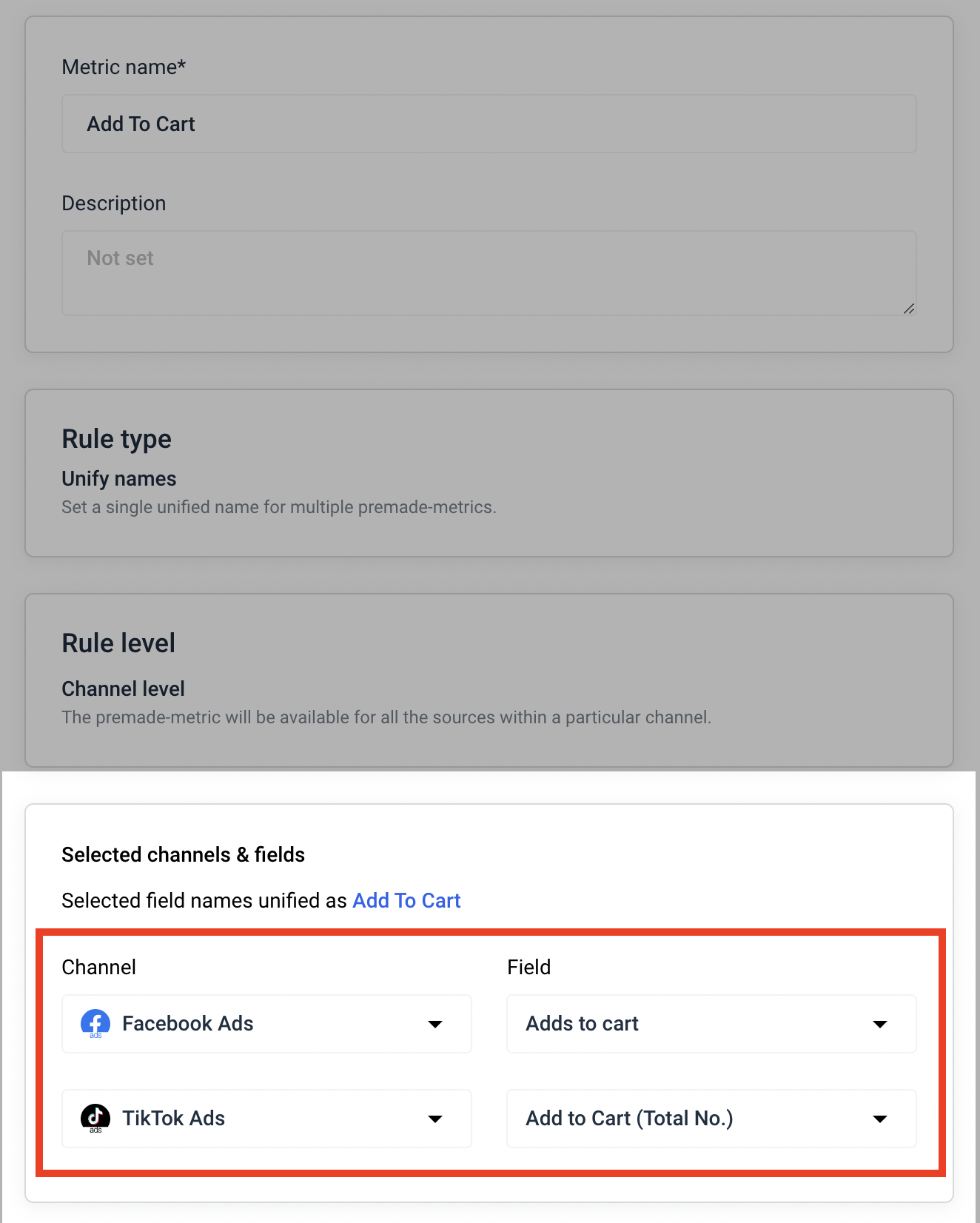 This video digs deeper into data organization on Whatagraph:
This video digs deeper into data organization on Whatagraph:
And with IQ Dimensions (available on more advanced plans), you don’t even have to do the heavy lifting yourself. It will:
- Create custom blends automatically. Just describe what you need—like “combine all spend from Meta, TikTok, and Google Ads into one unified Paid Media metric”—and IQ builds the blend for you.
- Build custom metrics on the fly. Want ROAS across channels? Or a funnel KPI like Add-to-Cart conversions? IQ can generate them instantly, without formulas or coding.
- Standardize messy data with IQ Dimensions. For example, if you’ve got campaign names like “FB_US_SpringSale_23” and “MetaUSA_Spring23,” you can tell IQ: “Group by Campaign Type: Spring Sale”. IQ creates a brand-new dimension that neatly categorizes everything, and you can reuse it across reports.
- Normalize any dimension at scale. Group campaigns by objective, products by category, or reviews by language—whatever fits your reporting needs. IQ makes sense of inconsistent data and saves hours of manual clean-up.
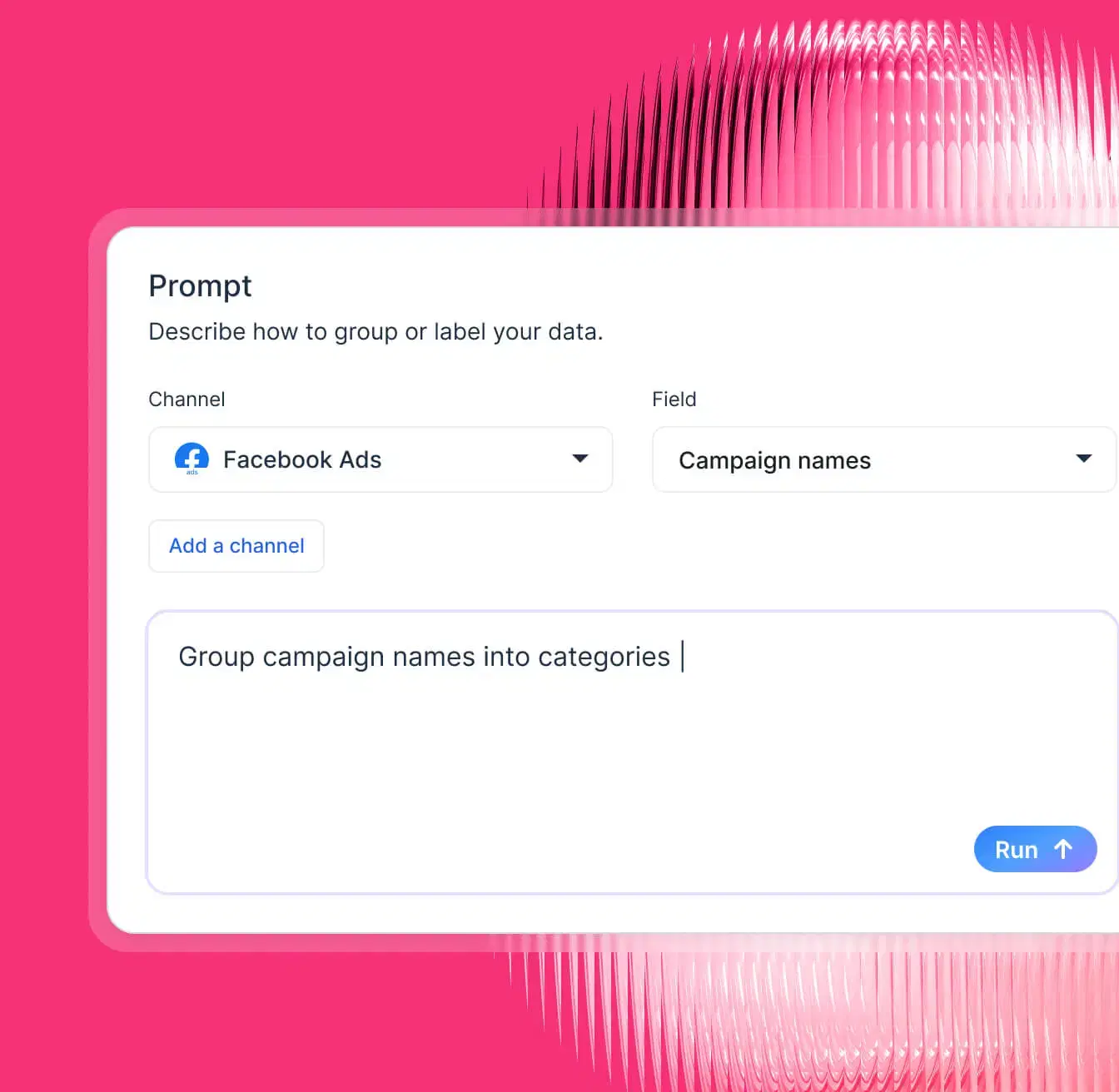
Another key feature that ex-Databox users love about Whatagraph is our Source Filter.
Previously, you’d have to apply the same filter widget by widget—painful if you’ve got 20 Facebook widgets in one report.
Now, with Whatagraph’s Source Filter, you apply the filter once at the source level, and it updates across every widget instantly. That means less time clicking around, and more time actually analyzing your data.
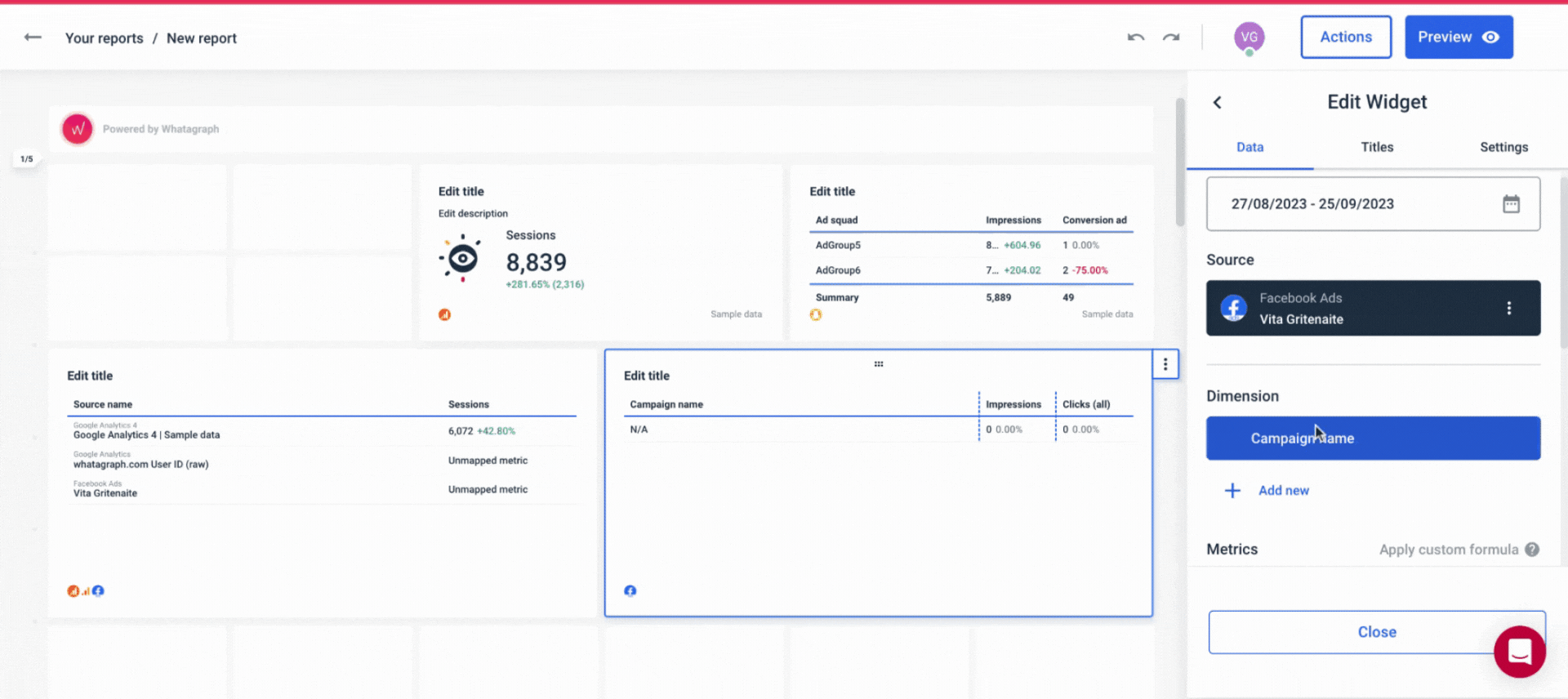
Powerful and easy data organization on Whatagraph means:
✅ Your reports are easier to read, neat, and tidy.
✅ Your clients clearly see the value you’re delivering rather than being stuck interpreting data.
✅ You can analyze and compare performance any way you want, and use these insights to deliver better results for clients.
4. Clean, sleek, and white-labeled reports
On Databox, data is presented in a “box” format (hence the name). This works for monitoring data by your internal team, but it’s not appealing for clients who want to see professional PDF-style reports.
In the image below, you can see how the metrics are “squished” together and difficult to read and understand. The background color can also be distracting.
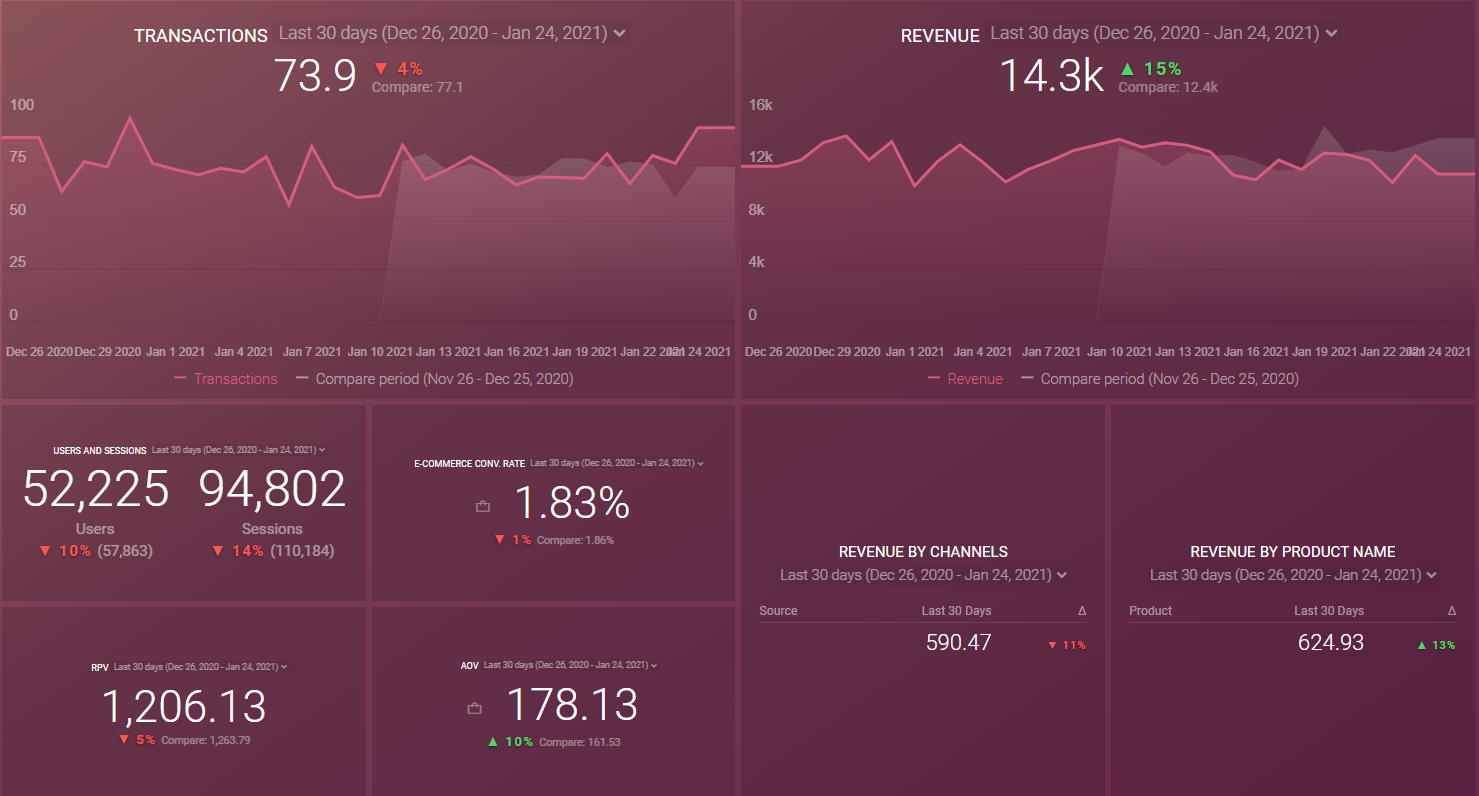 To create reports, you can either add this dashboard to a “report” slide or create a new slide from scratch.
To create reports, you can either add this dashboard to a “report” slide or create a new slide from scratch.
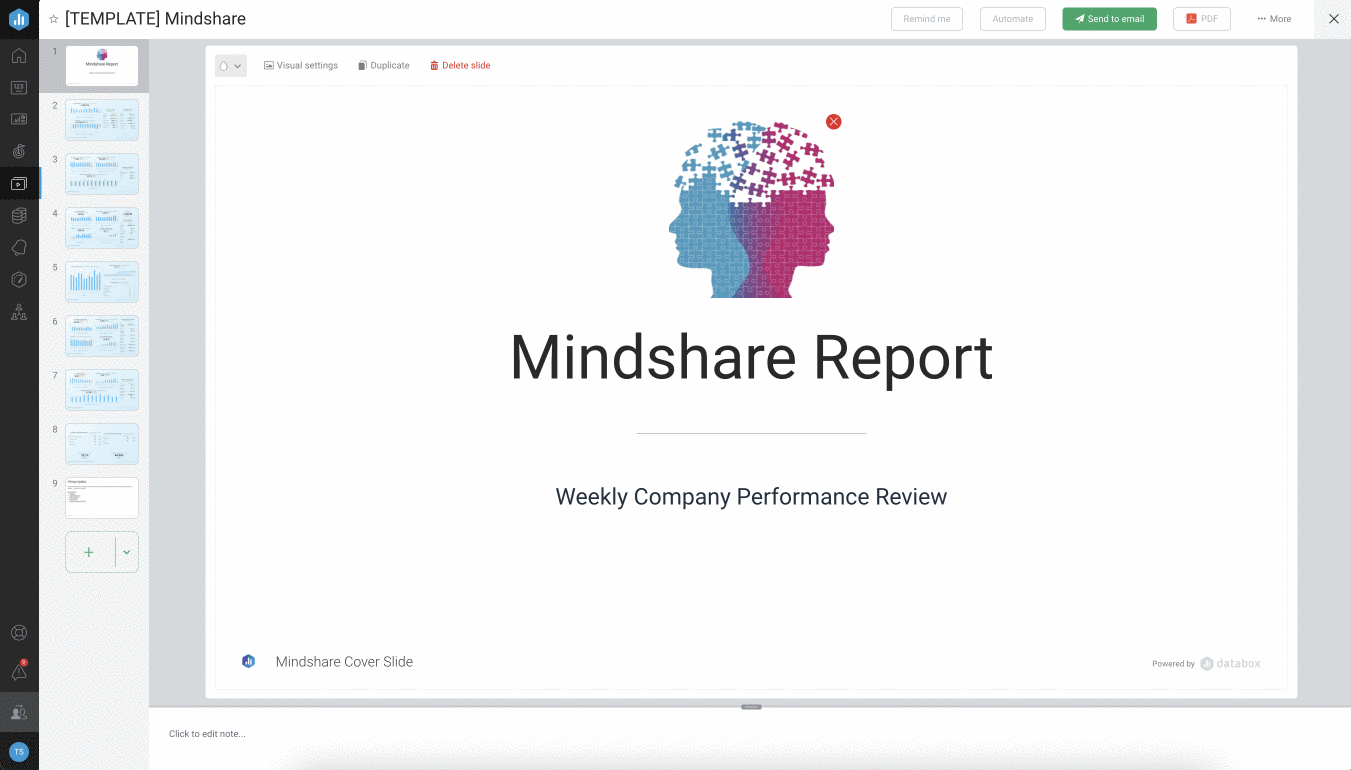 This PowerPoint-slide-style report might not be for everyone. Plus, you'll need to spend more time creating a report like this from scratch rather than downloading your dashboard as a report.
This PowerPoint-slide-style report might not be for everyone. Plus, you'll need to spend more time creating a report like this from scratch rather than downloading your dashboard as a report.
Whatagraph gives you full control over branding, so reports look professional and on-brand every time.
With IQ Themes, you can generate a complete report style in seconds. Here’s what you can do:
- Instant brand matching – Upload your client’s logo or an image (like a product shot or website screenshot), and IQ automatically generates a full theme: fonts, HEX colors, background styles, and even icon sets that match the brand identity.
- Prompt-based styling – Want something bold or seasonal? Just type it in (“Give this report a sleek fintech look” or “Make it a Halloween theme”), and IQ transforms the design instantly.
- Full customization – After IQ builds your theme, you can fine-tune fonts, add additional brand colors, and adjust layouts as much as you like.
- Reusable global themes – Once you’ve nailed the look, save it as a Global Theme. Apply it to any future report in one click, across all clients and campaigns.
This means you’ll always get stunning, professional, and fully-branded reports your clients or execs will actually want to read.
Here’s an example of a Shopify report template:
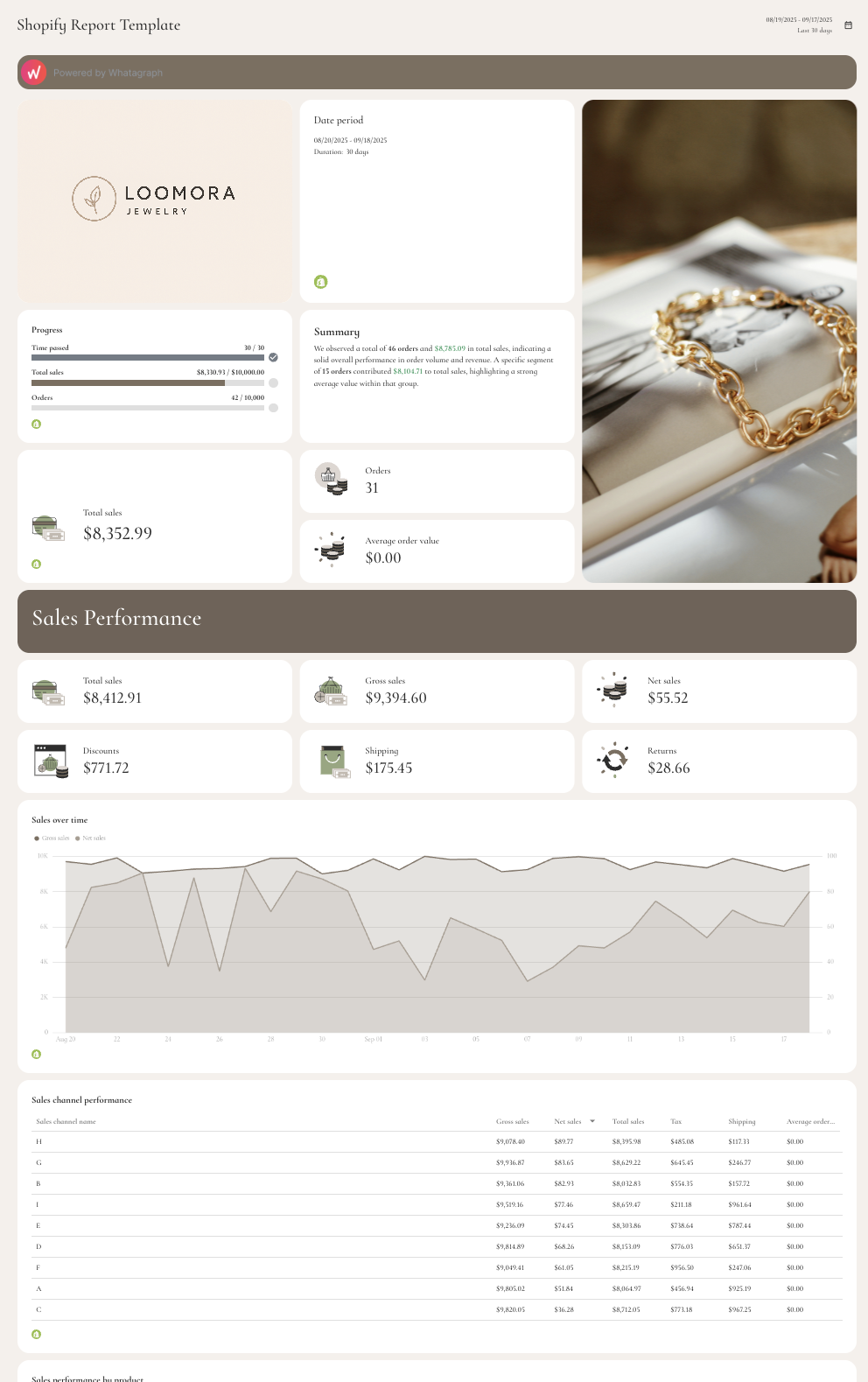
Here’s an example of a social media report template:
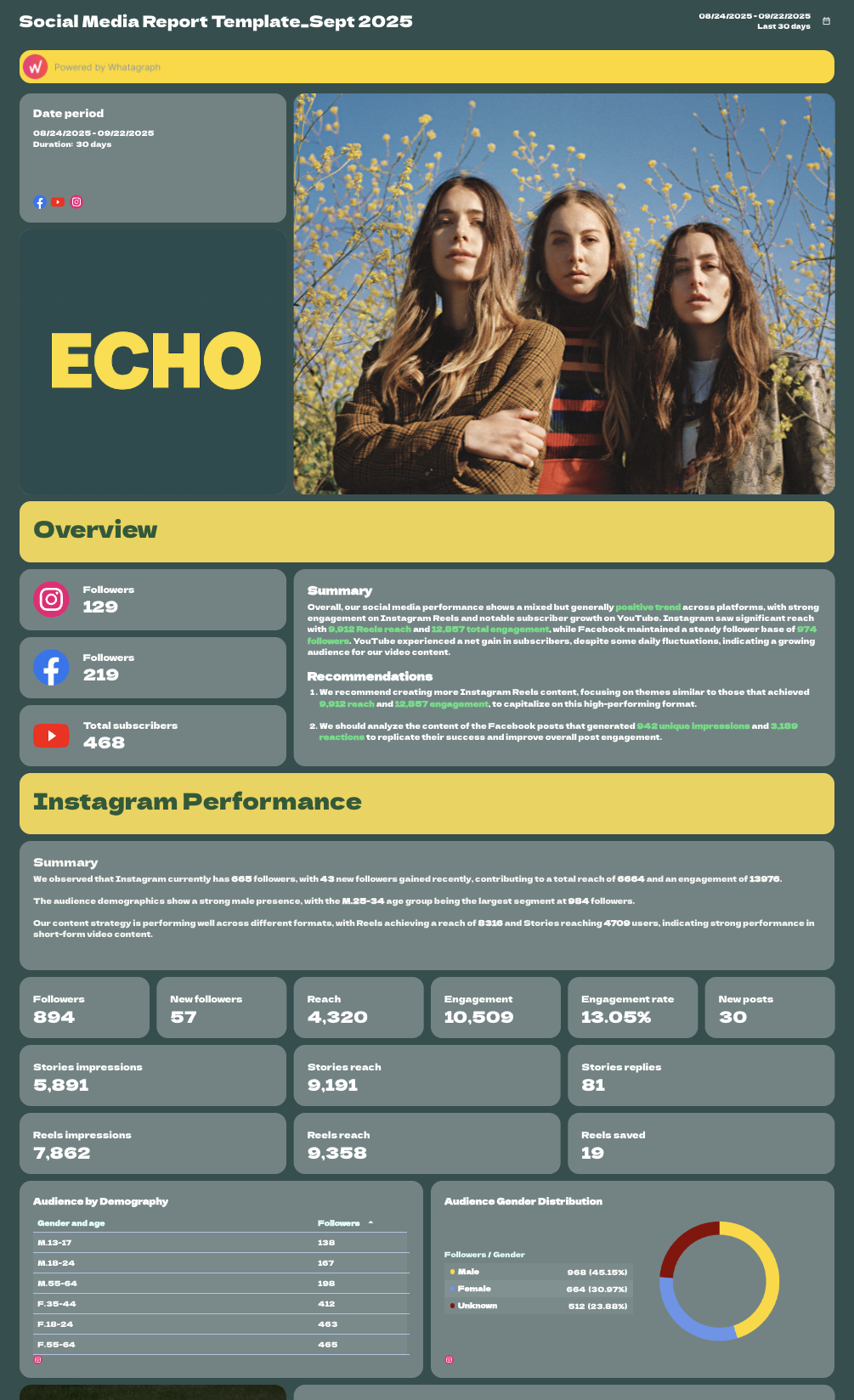
And here's an example of a paid-per-click report template:
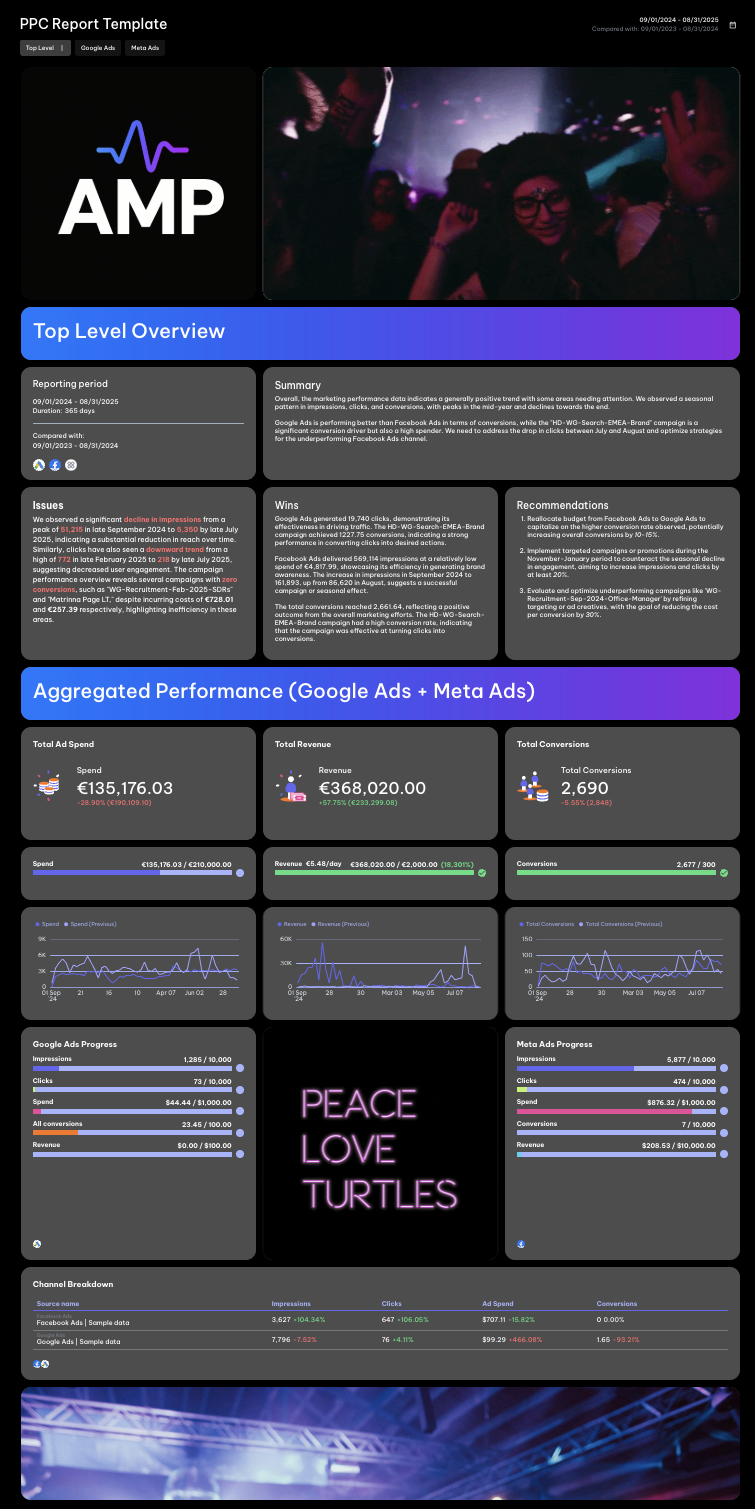
Start building your report for FREE.
And when the time comes for sharing these reports, you can either:
- Send automated emails to specific people at specific times, days, and cadence. Customize the email subject lines, body copy, and even domains.
- Send instant live links to anyone.
- Download PDFs or CSVs.
Apart from report sharing, you can also transfer your data to BigQuery on Whatagraph to have a centralized storage for your cross-channel data.
5. Fast and friendly customer support
Using a marketing analytics tool can be overwhelming. There are times you just need some (or a lot) of help from a product expert to get the platform up and running the way you want it to.
With Databox, however, it’s can be difficult to get the help you need when you need it.
Multiple reviews on G2.com and Capterra mention how Databox’s customer support is “unresponsive”. Emails sent to support get ignored and issues go unresolved for months. It's also important to note that “Priority Support” is only available on the expensive plans.
 On Whatagraph, all our pricing plans come with fast, friendly live chat support that responds to messages within 4 minutes and resolves most issues within 4 hours.
On Whatagraph, all our pricing plans come with fast, friendly live chat support that responds to messages within 4 minutes and resolves most issues within 4 hours.
In fact, this is one of the things that our customers love most about us. Kim Strickland, Digital Marketing Specialist at Peak Seven says:
I've joked about this often—with Whatagraph, we're not paying for a reporting system. We're paying for customer support. There's a level of dedication from the Whatagraph team that you don't often experience anywhere else.
And Stef Oosterik, Quality Manager at Dtch. Digitals said in 9 out of 10 cases, issues get resolved within a day.
The support team is very responsive. This makes it easy for us to give feedback, think of solutions, and get the right data visible for clients quickly.
For teams that need more tailored guidance, dedicated Customer Success Managers (CSMs) are available on advanced plans. CSMs work with you on migrations, onboarding, and building reporting workflows that scale.
Whether you’re on the entry plan or the enterprise tier, you’ll always have real people ready to help—fast.
6. Straightforward pricing, no hidden costs
At first glance, Databox looks affordable. But most of its plans come stripped down, and you’ll quickly run into paywalls:
- Professional plan ($159/mo): only 3 data sources included, then $5.60/month per extra source.
- Growth plan ($399/mo): adds datasets, AI summaries, and advanced filtering—but still limits syncs and integrations.
- Premium plan ($799/mo): only here do you get priority support, advanced security, guided onboarding, and faster refreshes.
- White-labeling isn’t included in any base plan—it’s a $200/month add-on. Faster syncs, advanced security, and even onboarding cost extra.
So while Databox seems “affordable,” essential features like support, refresh speed, and branding require stacking add-ons or upgrading to higher tiers.
Whatagraph’s pricing is more straightforward. You know exactly what’s in each tier:
- Start ($229/mo) → 20 source credits, essential integrations, Whatagraph IQ features (report creation, widgets, themes, summaries, chat), pre-made templates, and live chat support.
- Boost ($579/mo) → 60 source credits, advanced integrations, white-labeling, custom data transformations, performance overview, and a dedicated Customer Success Manager.
- Max (Custom) → 100+ source credits, premium integrations, custom data aggregations, SSO, tailored onboarding, and priority support.
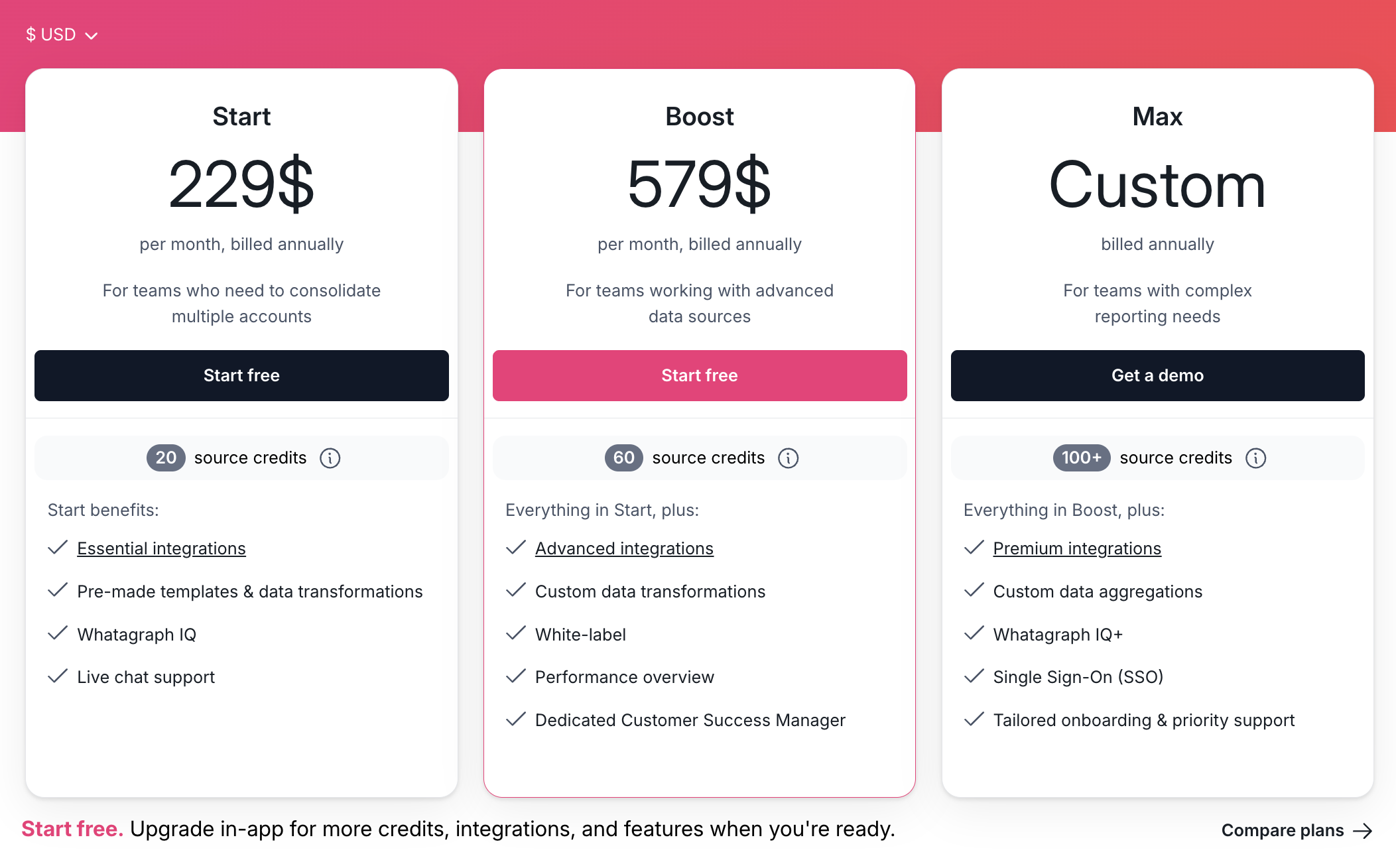 Here’s the side-by-side:
Here’s the side-by-side:
| Databox | Whatagraph | |
| Starting Price | $159/mo (3 sources) | $229/mo (20 sources) |
| Extra Data Sources | $5.60 each | Included via source credits |
| White-labeling | $200/mo add-on | Included in Boost & Max |
| Support | Email on lower tiers, priority only at $799+ | Fast live chat (<4 min response) on all plans; CSMs on Boost+ |
| Data Refresh | 15-min sync only on Premium (limited sources) | Fast refreshes included |
| Security | Advanced security only at $799+ | SSO & enterprise security at Max |
The key difference is that Databox locks essentials behind add-ons and expensive tiers, but Whatagraph gives you the full reporting stack—AI features, integrations, and support—upfront, with no hidden costs.
Convinced Whatagraph is the right Databox alternative for you? Start free today.
Key Features
- 55+ stable native integrations across paid ads, social, SEO, email, and more
- Custom integrations via API, Google Sheets, or BigQuery
- Whatagraph IQ – AI-powered reporting tools
- Versatile drag-and-drop widgets for reports and dashboards
- Custom metrics, dimensions, and data blends
- Performance monitoring overview
- Library of pre-made dashboard and report templates
- Insights – automatic audits of connected data, anomaly detection, and recommendations
- Spaces – organize reports with descriptions, colors, and better team alignment
- Custom branding and white labeling
- Automated report sharing via email or live dashboard links
- Exports: PDF, Excel, CSV, or transfer directly to BigQuery/Looker Studio
Whatagraph Reviews from Real Users
“To me, Whatagraph is like the Tesla or Mercedes of digital analytics tools, their clean and simple way to present complex marketing data. I highly recommend it to anyone working with marketing analytics who values efficiency and clarity in their reporting.” (Source)
“Whatagraph has a simple user interface that is easy to navigate even for those who don't have analytical skills.” (Source)
“What I like best about Whatagraph is having the ability to create reports fast and easy. No more spreadsheets to do reports, they have a great variety of templates.” (Source)
Pros and Cons
Pros:
- All-in-one marketing performance monitoring and reporting solution
- Easy to use by anyone on your team
- Fast campaign performance and insights
- Stunning visual reports
- Makes results easy to interpret
- Excellent live chat customer support
Cons:
- Just one data warehouse destination, BigQuery, is available so far
2. Klipfolio
Most suitable for: Large data teams at companies and large agencies
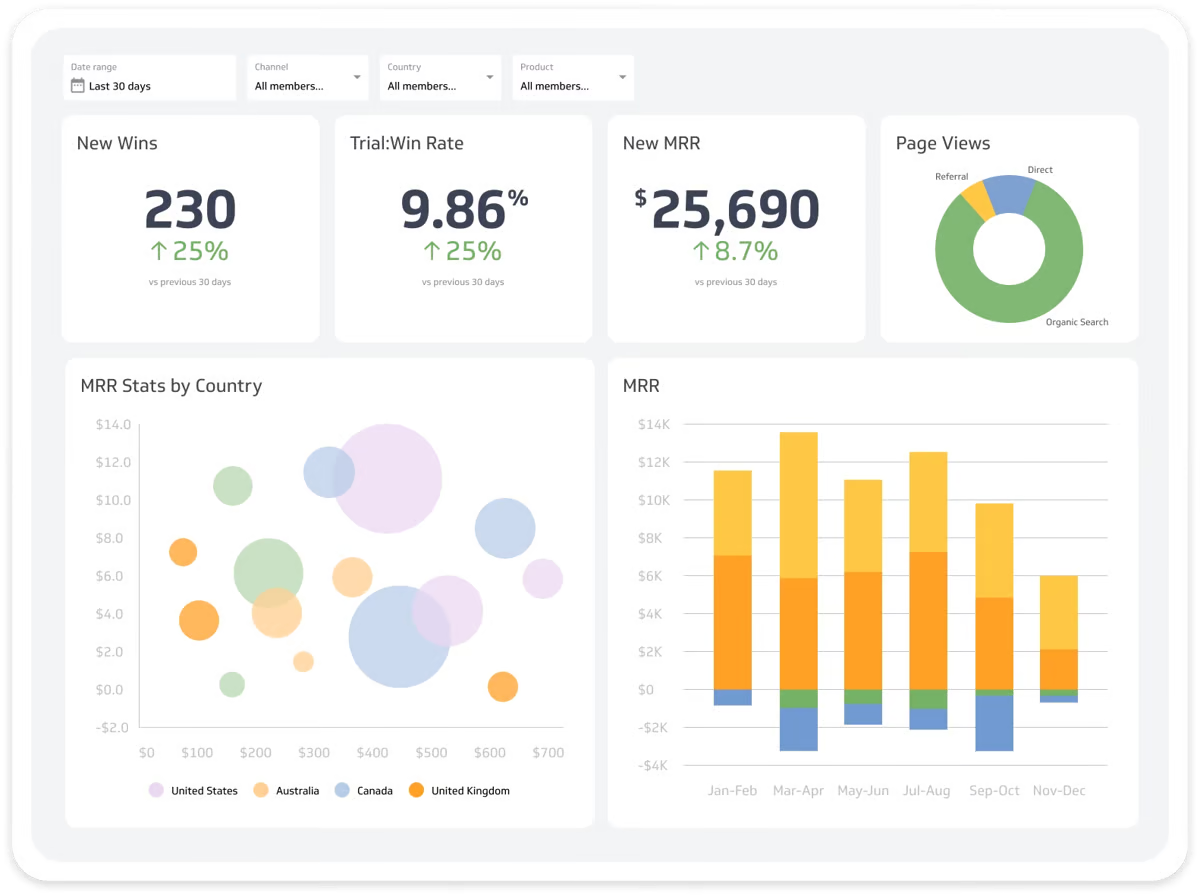
Klipfolio is a data analytics and a business intelligence tool in one. It offers two key products:
- PowerMetrics: Suitable for data teams at large companies, this is a data analytics solution to centralize, standardize, and share accurate metrics throughout the organization. Non-data teams can then use these certified metrics for their dashboards and reporting needs.
- Klips: These are your regular data visualization dashboards and reports. Klips integrates with 130+ platforms and you can also use a Rest/URL option for custom integrations.
Compared to Databox, Klipfolio is more reliable, real-time, and powerful with a wider variety of data organization features offered by PowerMetrics. It also comes with more integrations (130+) compared to Databox’s 90.
However, Klipfolio also comes with a steep learning curve like Databox, requiring CSS skills to customize your dashboard themes. Whatagraph still remains undefeated in terms of user-friendliness.
Key Features
- 130+ integrations including warehouses, SQL databases, and file-sharing services
- Data blending, unifying, aggregating
- Custom metrics and dimensions
- AI insights
- Custom dashboards and reports
- Export dashboards as PDF or image files. Export only individual clips as CSV
- Scheduled reports
Klipfolio Reviews from Real Users
“Klipfolio has a user-friendly interface. It can be easily connected with databases, Excel sheets, and Google sheets which makes data integration very smooth and easy.” (Source)
“I love the full range of capabilities that are possible when building a Klipfolio dashboard (specifically with their Klips product).” (Source)
“Every time I contact support I get the impression that I am bothering them. I will not be renewing this platform because I do not feel valued as a customer.” (Source)
Pros and Cons
Pros:
- Easy to use and set up
- Powerful data analytics and organization options
- AI insights to help make data-driven decisions
Cons:
- Expensive with important features only available as add-ons or in Enterprise plans
- Limited customization for dashboards and templates
- Unhelpful customer support
Klipfolio Pricing
Klipfolio offers three pricing plans for two of their products: PowerMetrics and Klips.
As of October 2024, here are the plans for PowerMetrics:
- 30-day free trial
- Professional: $300/month for 10 users and unlimited metrics.
- Enterprise: Custom pricing for 10 users, unlimited metrics, and priority support.
It’s also important to note that important features like data warehouse integrations, AI insights, and custom domains are only available as add-ons, unless you purchase the Enterprise plan.
Klips’ pricing is further divided into plans for businesses and for agencies.
As of October 2024, here are the plans for businesses:
- Grow: $190/month for 15 dashboards and 1 hr data refresh rate. No priority support or custom onboarding available
- Team: $350/month for 30 dashboards and 15 min data refresh rate. No priority support or custom onboarding available
- Team+: $690/month for 60 dashboards and up to the minute data refresh rate. Includes priority support and custom onboarding
As of October 2024, here are the plans for agencies:
- Agency Lite: $190/month for 20 dashboards, 20 clients, and 1 hr data refresh rate. No priority support or custom onboarding available.
- Agency Pro: $420/month for 40 dashboards, 40 clients, and 30-min data refresh rate. No custom onboarding available.
- Agency Premier: $1025/month for 70 dashboards, 70 clients, and 30-min data refresh rate.
Side note: On Whatagraph, you can get unlimited dashboards, unlimited clients, 30-min data refresh rate, priority support, and custom onboarding on ALL our plans. Reach out to us for a pricing plan just for you.
3. Tableau
Most suitable for: Data teams at large enterprises
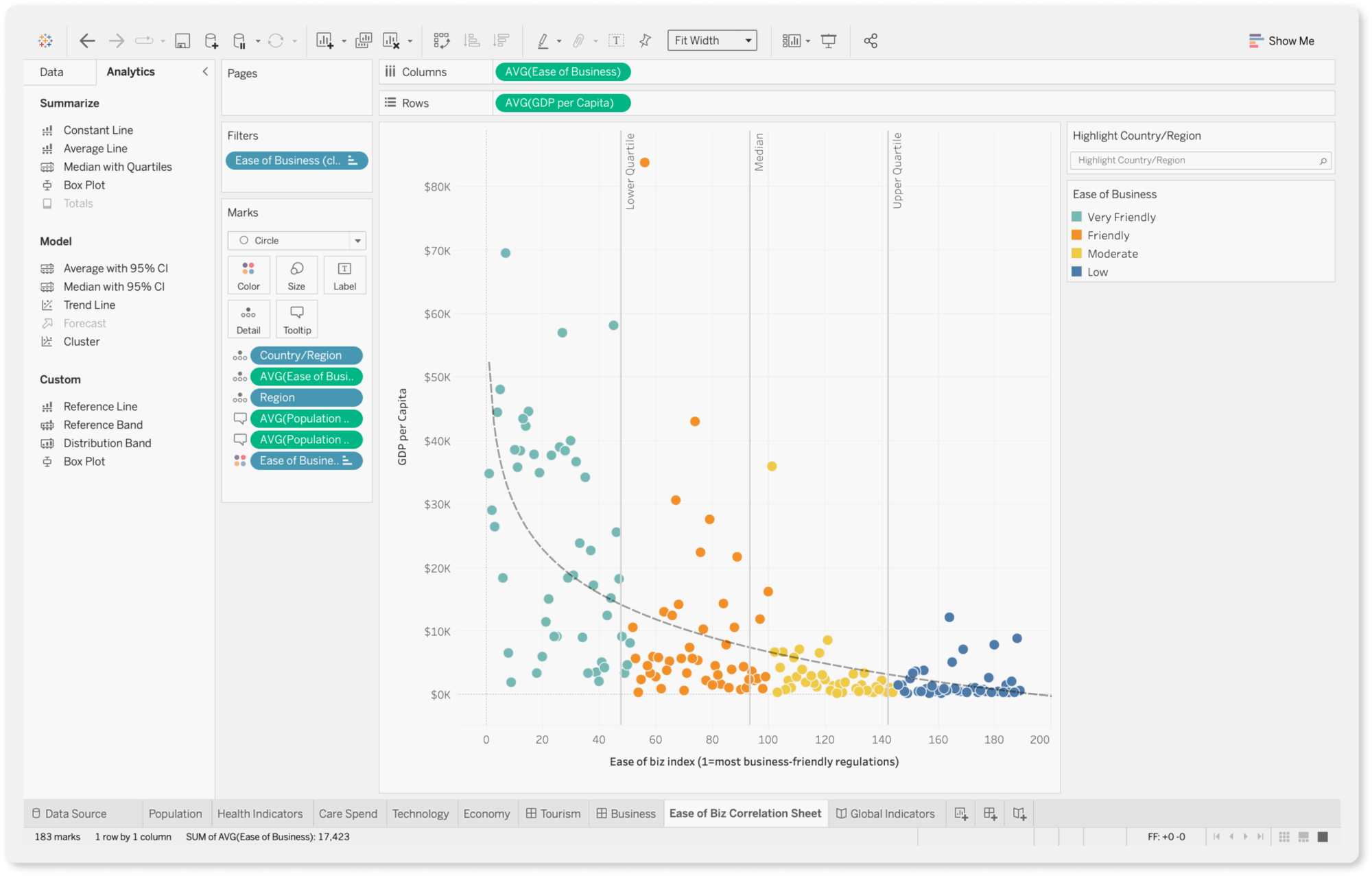
If you’re looking for an enterprise-level business intelligence solution, Tableau is a great choice.
For a powerful data analysis tool, Tableau is still easy to use with a drag-and-drop interface and visual query builder. You can generate insights quickly and share them with stakeholders through reports.
The charting and data exploration features are more sophisticated than Databox, as Tableau provides robust analytics capabilities, including support for advanced calculations, statistical functions, and predictive modeling.
You can perform complex data analysis, uncover trends, and identify opportunities for optimization using features such as trend lines, forecasting, and clustering.
What’s more Tableau boasts quite a large and active user community called “Tableau Community Forums” with a wealth of resources, forums, and online training materials to help you learn the platform and troubleshoot issues.
You can also purchase “Success Plans” that come with personalized training and support.
However, Tableau is (a lot) more expensive than Databox as it’s mainly for enterprises.
Key Features
- 90+ integrations
- Custom metrics and dimensions
- Data blending
- Drag-and-drop dashboard interface
- AI-powered insights
Tableau Reviews from Real Users
“Tableau allows me to create my own structured data from a lot of unstructured data.” (Source)
Tableau has an uncanny ability to transform complex data into visually stunning and easily understandable representations.” (Source)
“Tableau can be costly, particularly for startups.” (Source)
Pros and Cons
Pros:
- Powerful data analytics and visualization
- Easy to use and implement
- Seamless data integrations
Cons:
- Can be expensive if you need advanced features
- Takes a lot of time to load for large datasets
- All the preprocessing of the data (data cleaning) has to be done beforehand. Data cleaning cannot be done in Tableau
Tableau Pricing
As of October 2024, Tableau offers three pricing plans:
- Viewer: $35/user/month, billed annually
- Explorer: $70/user/month, billed annually
- Creator: $115/user/month, billed annually
4. Looker Studio (a.k.a. Google Data Studio)
Most suitable for: Freelancers and boutique agencies
Google’s free reporting tool, Looker Studio, is a popular choice among marketers.
Looker Studio comes with 21 native integrations with Google-based platforms like Google Ads, DV 360, Google Sheets, and Google Analytics. You can also connect to BigQuery, MySQL, and Microsoft SQL servers on Looker.
Once your data sources are connected, you can use Looker’s drag-and-drop report editor to ad:
- Charts, line bars, pie charts, geo maps, area and bubble graphs, data tables, pivot tables
- Filters and date range controls
- Links and clickable images
- Custom text and images
- Custom styles and color themes
You can then invite teams or clients to view or edit your reports, or send them links in scheduled emails.
Many of the ex-Databox users we’ve talked to say they had to use Looker Studio together with Databox because the former was more reliable and stable than the latter.
However, they were still facing the same challenges like slow load times, data breakages, and inaccurate data on Looker Studio.
Key Features
- 21 native connectors (free)
- 1000+ “partner” connectors (paid)
- Drag-and-drop report builder
- Data blends
- Custom images and text
- Custom styles and color schemes
- Mobile app
Looker Studio Reviews from Real Users
“I love the way you can present data from multiple sources in one report. I also love the ability to blend different tables and show the information in one chart.” (Source)
“Unfortunately, connectors break quite regularly and reports containing a lot of data can take a lengthy time to load.” (Source)
“Looker studio needs more report downloading options such as Word and PDF.” (Source)
Pros and Cons
Pros:
- Free (to an extent)
- A huge range of data visualization formats and options
- Easy to use for basic reports
Cons:
- Slow loading
- Connection breakages and inaccurate data
- Limited report sharing options (no Word, Sheets, or PDFs)
Looker Studio Pricing
Looker Studio is free for connections with 21 native integrations, which are mostly Google-based platforms.
5. Geckoboard
Most suitable for: Medium to large businesses in the Customer Service, Sales, and eCommerce sectors
Geckoboard is an easy to use dashboard software for Customer Service, Sales, and eCommerce businesses.
With it, you can connect to 90 data sources, design your dashboard, and share the dashboard with your team members or the C-Suite.
Once your data is connected, you can create three main types of dashboards:
- A blank dashboard (similar to Whatagraph’s)
- TV dashboards for internal presentations
- Mobile dashboards
- Snapshots and reports
Another cool feature about Geckoboard is its “KPI notifications” which sends notifications when KPIs trend up or down via Slack.
Geckoboard’s main superiority over Databox is its ease of use. Users online say you can create beautiful dashboards for clients and teams without any technical knowledge.
However, unlike Whatagraph, you won’t be able to create custom data blends, metrics, and dimensions on Geckoboard. This can be a deal breaker if you’re a large company and you need to organize your scattered data to create easy to read and impactful reports.
Key Features
- 90+ integrations with Customer Service, Sales, Finance, and eCommerce channels
- Drag-and-drop dashboard builder
- KPI notifications
- Slack integration
- Automated email reports
- TV dashboards
- Mobile-friendly dashboards
- Dashboard examples for businesses
Geckoboard Reviews from Real Users
“I love how simple it is to use. That you can connect data from so many different sources in an easy way.” (Source)
“Connecting the dashboard with the Tv works like a charm.” (Source)
“Geckoboard could use more features and options for customization. Compared to other tools like Power BI or Tableau, Geckoboard didn't have as many advanced tools for analyzing data or changing how things looked. I wished I could make more complicated charts and do special calculations.” (Source)
Pros and Cons
Pros:
- Easy to use and set up
- A wide variety of integrations
- Great customer service
Cons:
- Can be pricey if you want to add more dashboards
- Limited customization options for dashboards
- No advanced calculations, blends, and custom metrics and dimensions supported
Geckoboard Pricing
Geckoboard’s pricing is based on the number of dashboards. But unlike DashThis (which includes unlimited users), Geckoboard has limitations on the number of users.
As of October 2024, Geckoboard offers three pricing plans:
- Essential: $149/month for 5 dashboards, 3 users, 1 TV share, and core data sources
- Pro: $199/month for 5 dashboards, 10 users, 3 TV shares, and pro data sources
- Scale: $699/month for 30 dashboards, 25 users, 10 TV shares, pro data sources, and dedicated Support rep
6. DashThis
Most suitable for: Small businesses and freelancers
DashThis is a simple marketing reporting tool that connects to 30+ marketing platforms and visualizes KPIs on dashboards.
If you don’t see a built-in integration you need, you can also upload your own data using a nifty CSV file or a Google sheet.
Once your data is connected, you can visualize it using three key dashboards:
- Periodic dashboards: These are dashboards based on specific time periods and cadence, like daily, weekly, monthly, semi-annually, and annually.
- Campaign dashboards: These dashboards are used to isolate and highlight a specific campaign for a custom date range.
- Rolling dashboards: These dashboards show trends of metrics for three different date ranges.
These dashboards are also pre-made, meaning you can quickly get started rather than spending hours building dashboards like on Databox.
On the more pricier plans, you’ll get a dedicated product specialist assigned to you who will help you set up your dashboards.
However, DashThis is more suitable as a reporting tool rather than a data analytics platform. There are very few options to customize or organize your data on DashThis.
For instance, if you’re at a marketing agency and you have international clients, you might want to convert the currency of cost metrics on your reports. DashThis doesn’t allow you to do so, while Whatagraph does.
Also, you can only “merge” widgets together in DashThis; you can’t blend data sources to the full extent or create advanced metrics and dimensions. On Whatagraph, you can easily organize your data any way you’d like using simple workflows.
Key Features
- 30+ integrations
- Custom data upload via CSV file or Google sheets
- Visualization dashboards
- Automatic data refreshes
- Upload client or band logos
- Create custom widgets, domains, color schemes, and email addresses
- Library of report templates
- Report sharing via email, URL, or PDF
DashThis Reviews from Real Users
“DashThis is super user friendly. I am someone who doesn't know too much about Data Dashboards, but this platform was super easy to use.” (Source)
“There are some limitations to what you can bring in and they don't yet offer custom calculations.” (Source)
“It is a little annoying to move things around in a dashboard. You have to move each individual widget to a new section rather than moving an entire section in a dashboard.” (Source)
Pros and Cons
Pros:
- Easy to use and set up
- Many templates and dashboard examples available
- Relatively inexpensive
Cons:
- Limited data organization and customization features
- Limited data integrations
- Basic-looking reports
DashThis Pricing
As of October 2024, DashThis offers four pricing plans:
- Individual: $49/mo or $42/mo, paid yearly. Includes 3 dashboards. No white-labeling features, personalized onboarding, or priority support.
- Professional: $149/mo or $127/mo, paid yearly. Includes 10 dashboards. No personalized onboarding or priority support.
- Business: $289/mo or $246/mo, paid yearly. Includes 25 dashboards, white-labeling, personalized onboarding, and priority support.
- Standard: $449/mo or $382/mo, paid yearly. Includes 50 dashboards, white-labeling, personalized onboarding, and priority support.
7. Grow
Most suitable for: Data analysts at medium to large enterprises
Grow is a no-code full-stack business intelligence platform that combines ETL, data warehousing, and visualizations on one platform.
You can connect to 75 data sources through native integrations, including popular CRM platforms, marketing analytics tools, databases, and accounting software.
Then, you can prepare and cleanse your data using either noSQL or SQL transformations. This includes custom calculations, data blends, and advanced data filters.
Plus, Grow stores your data automatically on its platform so you don’t need to ship it to a third-party data warehouse.
You can create three types of dashboards on Grow:
- Dynamic dashboards which display data based on who is logged into the account.
- Dashboard Blueprints which are pre-built, single data source dashboards
- Custom & Sandbox dashboards which shows blended data sources and metrics
These dashboards also come with powerful filtering options based on date, number, or categorical logic.
You can then share them through emails, shareable URLs, Slack, TV-mode, or tables of raw and transformed data.
The key advantage of Grow over Databox is its reliability. The platform uses APIs to import data seamlessly from data sources, and it continually refreshes the data so your metrics are up-to-date and reliable.
However, Grow is more suitable for internal data storage and monitoring rather than for external reports. Their dashboards are very nitty-gritty which can overwhelm clients or the C-Suite.
Key Features
- 75 native integrations
- Built-in data storage
- SQL or non-SQL based data transformations
- Customizable dashboards
- Advanced data analytics and predictive modeling
- Real-time data updates
Grow Reviews from Real Users
“As an analyst, I have recently started working on this tool and this is by far the best. It helps me to create powerful data visualisation as well as to gain insight from that data.” (Source)
“The interface could be better and overall user experience creates lag sometimes.” (Source)
“The back end seems quite complex to work so really need an IT expert to do the set up, but once it's working it's great for users.” (Source)
Pros and Cons
Pros:
- Inuitive, easy to use interface
- 24/7 customer support
- No-code data pipelines, storage, and visualizations
Cons:
- Occasional lags
- Expensive
- Slow performance when dealing with large volumes of data
Grow Pricing
Grow doesn’t share their pricing publicly.
8. NinjaCat
Most suitable for: Marketing agencies and brands with dedicated data scientists
NinjaCat is an end-to-end platform for connecting to your data sources, cleaning the data, visualizing it, and shipping it to destinations.
You can integrate with 100+ pre-built connectors, ranking from CRM, search advertising, web analytics, and project management tools.
You can then simplify and harmonize your data with no-code transformations and custom calculations. There’s also the option to store your data in a managed warehouse. Or, you can ship your data to external storage destinations like Snowflake, BigQuery, or Amazon S3, or business intelligence destinations like Tableau and Looker Studio.
When it comes to creating reports, you can start from a blank template (that looks like a “canvas”) and add and adjust metric widgets as needed.
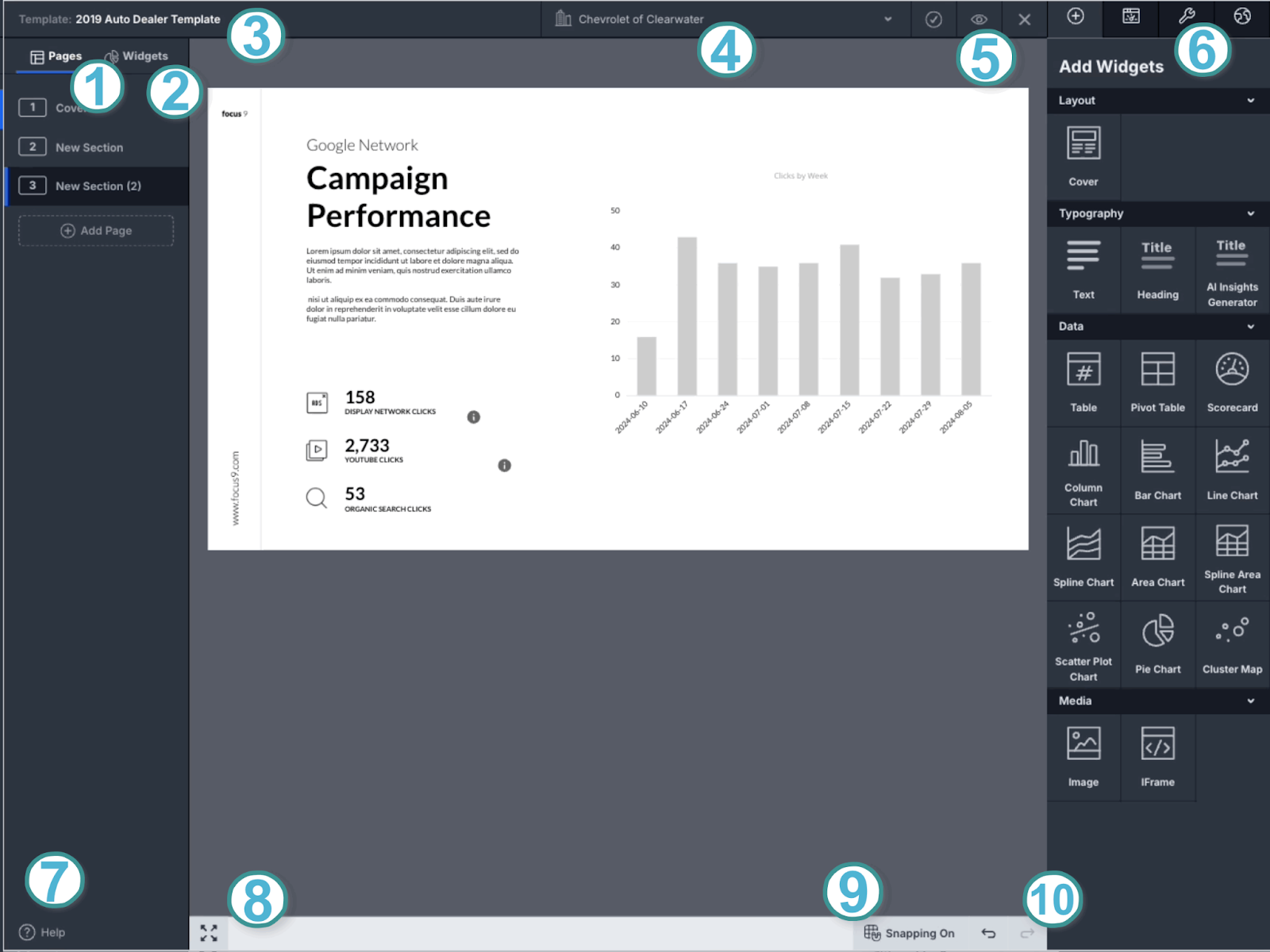
Graphic designers will be familiar with this layout as it looks a lot like a popular design tool—Figma. However, if you’re a marketer without a design background, this can be quite confusing and overwhelming.
NinjaCat’s main advantage over Databox is its responsive and helpful customer support. Users online say their support team is always available to answer questions and are open to feedback.
Key Features
- 100+ pre-built connectors
- No-code transformations and calculations
- Data transfer to BI tools and data warehouses
- Easy ad spend and campaign performance monitoring
- White-label options
- White-glove setup and service
NinjaCat Reviews from Real Users
“I love how it pulls in our data across several different platforms into one cohesive report.” (Source)
“The support the NinjaCat provides is exceptional.” (Source)
“I found a lot of the functionality on Ninjacat to be really clunky, unfortunately things take a LONG time to process if you're adding more than one filter to a table.” (Source)
Pros:
- Automated client reporting
- One platform for integration and visualization
- Multiple choice of destinations
- Custom branded reports
Cons:
- Separate workspaces to organize and visualize data
- Complex visualization builder
- Performance issues with reports
- No autosave in case of a crash
NinjaCat Pricing
NinjaCat doesn’t offer fixed pricing plans, and no information is available on its website.
9. Cyfe
Most suitable for: Boutique SEO agencies
Cyfe is a business dashboard app that helps you easily monitor your business data from one place and make better decisions.
You can pull data from 100+ integrations including social media, email, SEO, and sales and finance tools. You can also bring in custom data via .CSV, Google Sheets, SQL, private URL, or push API.
To build visualizations, you can start from their dashboard templates or pre-built widgets. The platform also comes with “Embedded Analytics” where you can take an entire dashboard or a widget and embed it to emails, webpages, or applications.
For SEO managers, Cyfe offers a built-in keyword ranking tool which allows you to automatically monitor website rankings across Yahoo, Google, and Bing.
The unique thing about Cyfe is that it supports 15 languages, including Korean, Turkish, and French.
However, Cyfe does not come with any advanced data calculations or organization features, nor can you transfer data to warehouses or other destinations.
Key Features
- 100+ integrations
- A wide library of dashboard templates
- Embedded analytics
- Custom and pre-build widgets
- Built-in keyword tracking tool
Cyfe Reviews from Real Users
“It's very easy to create your dashboard and populate it with widgets from different data sources like social media, email marketing software, CRM, or just custom data in a spreadsheet.” (Source)
“The dashboards were very limited on customization and creating calculated fields.” (Source)
“Support really sucks. This never used to be the case BTW.” (Source)
Pros and Cons
Pros:
- Easy to use and set up
- Wide range of integrations
- Affordable price
Cons:
- Incorrect data on widgets
- Poor customer service
- Limited customization and data transformation features
Cyfe Pricing
As of October 2024, Cyfe offers five pricing plans:
- Starter: $19/month for 2 dashboards and 1 user
- Standard: $29/month for 5 dashboards and 2 users
- Pro: $49/month for 10 dashboards and 5 users
- Premier: $89/month for 20 dashboards and unlimited users
- Agency: $150+/month for 100 dashboards, 15 users, 10 clients, and white-labeling features
10. Improvado
Most suitable for: Data teams and marketing teams at large companies
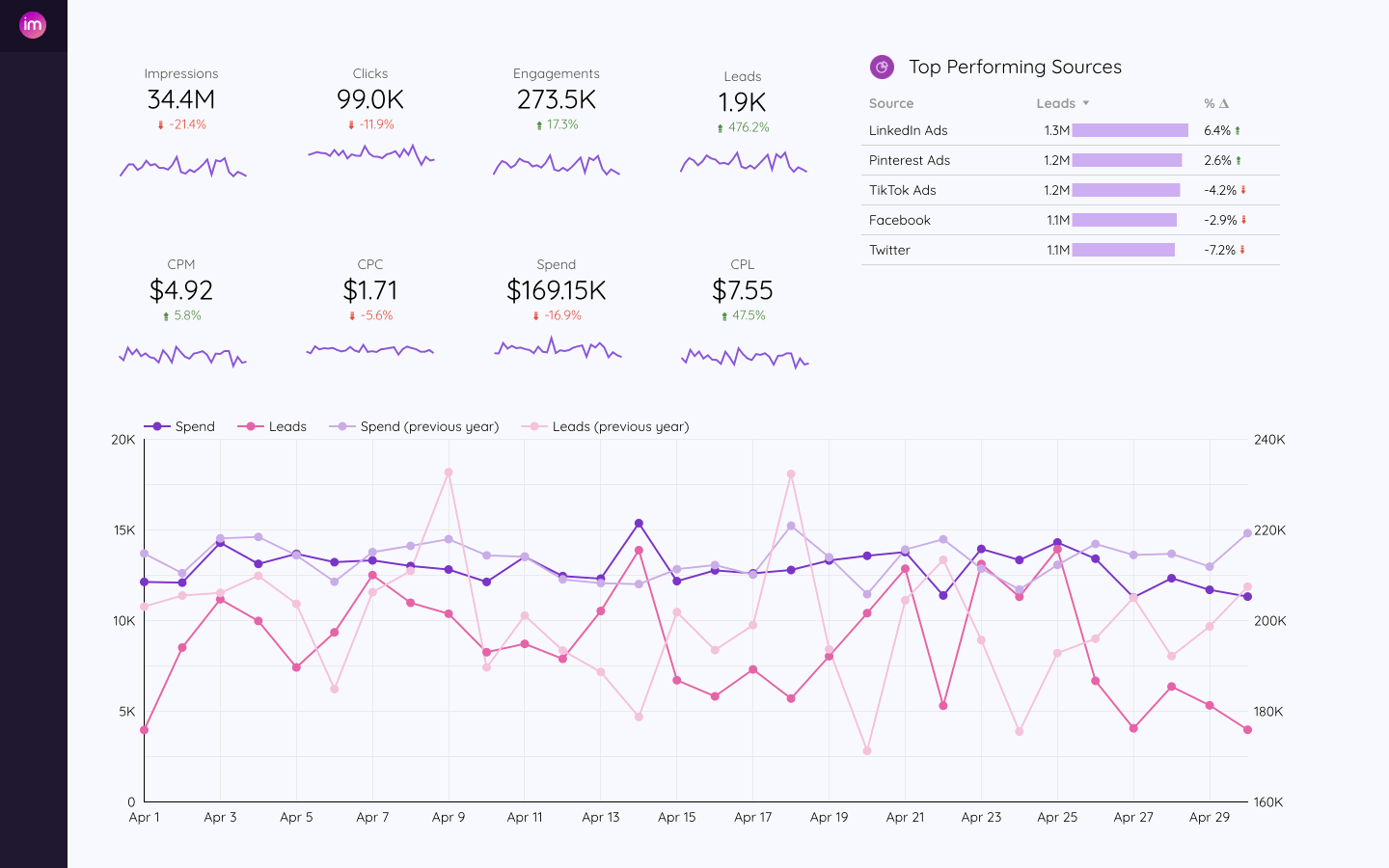
Improvado is an end-to-end data pipeline platform that gathers data from marketing platforms, MarTech tools, and CRMs, transforms this data, and ships it to various destinations.
You can integrate with over 500 channels and harmonize and clean your data into an unified dataset.
You can then push this cleaned data to visualization tools, data warehouses, and spreadsheets, or keep your data in a fully-managed storage.
However, Improvado is an ETL tool (Extract, Transform, Load), which means you’ll need to move your data to a third-party tool like Looker Studio to visualize it.
Improvado’s uniqueness lies in its AI-powered “campaign governance” solution which automatically validates campaign targeting, naming conventions, brand safety, KPI pacing, and more. It also validates the consistency of your performance metrics and alerts you about any issues.
But because of the vast features available, it can take months to implement Improvado. This makes it a more suitable tool for enterprises who need a powerful data analytics platform, but it may be overkill for marketing agencies and small businesses.
Key Features
- 500+ integrations
- Fully-managed data storage
- Unlimited data destinations
- Pre-built dashboards
- AI-driven data transformations
- Marketing attribution
- AI-powered campaign governance
- AI-insights
Improvado Reviews from Real Users
“There are a lot of ETL tools and a growing amount of AI companies, but Improvado's customer relationships and willingness to go above and beyond really sets them apart.” (Source)
“The best aspect of Improvado is their extensive range of integrations across major social, search, and ad-server platforms.” (Source)
“Improvado can be expensive, particularly for smaller businesses or startups with limited budgets.” (Source)
Pros and Cons
Pros:
- Powerful data analytics
- AI-powered insights
- Helpful customer support
Cons:
- Can be expensive for small businesses and agencies
- Long implementation time
- Steep learning curve
Improvado Pricing
Improvado doesn’t share their pricing publicly but based on online reviews and blog articles, the total cost can be anywhere between $2,000-$5,000 per month.
11. TapClicks
Most suitable for: Medium to large companies with PPC and SEO campaigns
TapClicks is a unique digital marketing platform in the sense that it’s eight different products bundled into one. Here’s a breakdown of each of them:
- TapData: Extract, transform, and load your data from one platform to another. Create data blends and complex transformations to format your data how you need it.
- TapReports: Visualize, optimize, and share your data with clients in customizable dashboards and automated reports.
- TapAnalytics: Discover trends and opportunities from your data.
- TapInsights: Get AI-powered insights and recommendations to optimize your campaigns.
- TapOrders: Automate orders and enter client objectives and goals at the point of sale. Connect a CRM, import files and create online forms for any product. Best for eCommerce businesses.
- TapWorkflow: Automatically route tasks based on your business processes and streamline your fulfillment workflow. Best for project managers.
- Raven by TapClicks: Perform site audits, rank tracking, link-building, and keyword research with in-depth insights and analysis. Best for SEO managers.
- Competitive Intelligence: Get local SEM data intelligence to create better proposals and to win more clients.
This all sounds great but TapClicks does seem to be a bit of a “Jack of all trades, master of none”. Based on online reviews, their connections break constantly, the data on reports is inaccurate, and the platform is difficult to use (even with 6 months of support from a CSM).
Key Features
- Wide variety of integrations (their website doesn’t say exactly how many)
- Advanced data calculations
- Data Exporter to load data into data warehouses, databases, and data visualization tools
- Interactive dashboards
- AI-powered insights
- Report automation
TapClicks Reviews from Real Users
“What I like best about TapClicks is that it simplifies marketing data by pulling everything into one easy-to-use dashboard.” (Source)
“I dislike TapClicks because the initial setup can be a bit overwhelming, and sometimes the data syncing isn't as smooth as I'd like.” (Source)
“After months of calls and time invested, we still had inaccuracies in the data.” (Source)
Pros and Cons
Pros:
- Powerful data analytics
- Customizable and interactive dashboards
- Responsive customer support
Cons:
- Steep learning curve
- Data inaccuracies
- Connection issues and lags
TapClicks Pricing
TapClicks’ pricing can be confusing as you’ll need to build your own packages.
You start by choosing your data package:
- TapDataLite: $99/month for 64 connectors
- TapData+: $349/month for 250+ connectors
- TapData Max: $649/month for 250+ connectors and API access
Then, you choose your data destination:
- TapReports: $199/month
- TapAnalytics: $899/month
- TapInsights: $1399/month
- Third-party destinations: Custom pricing
All packages come with 10 clients and unlimited users.
Based on these pricing plans, the total cost of TapClicks can come down to 1000s of dollars a month if you want a complete data stack.

WRITTEN BY
YamonYamon is a Senior Content Marketing Manager at Whatagraph. Previously a Head of Content at a marketing agency, she has led content programs for 5+ B2B SaaS companies in the span of three years. With an eye for detail and a knack for always considering context, audience, and business goals to guide the narrative, she's on a mission to create genuinely helpful content for marketers. When she’s not working, she’s hiking, meditating, or practicing yoga.